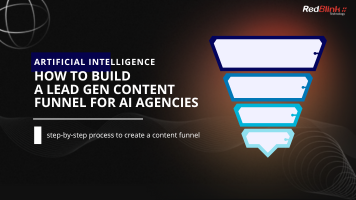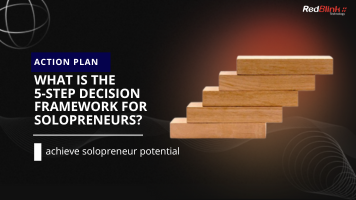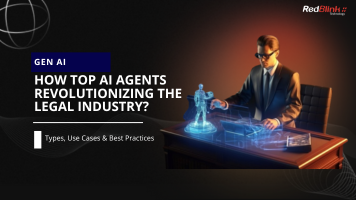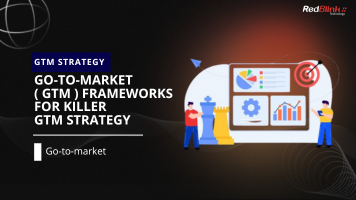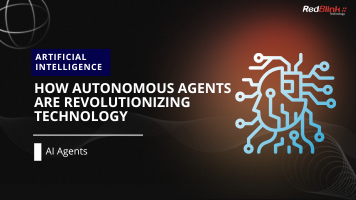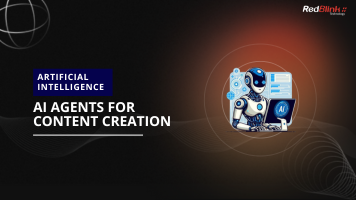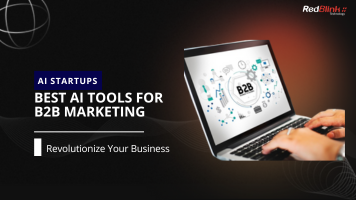Loveneet singh
Jlama vs Ollama vs vLLM: LLM Inference Engine Comparison
With the rise of large language models (LLMs), integrating AI into applications has become more accessible than ever. However, choosing the right LLM inference engine is crucial to unlocking the full potential of these technologies. Whether you're a developer seeking seamless Java integration, a business prioritizing privacy, or an enterprise needing scalability, selecting the right tool can significantly impact your application's performance and success.
In this blog, we’ll explore three leading inference engines—Jlama, Ollama, and vLLM—each catering to specific needs:
- Jlama: Optimized for seamless integration into Java applications.
- Ollama: A privacy-first tool for on-device AI inference.
- vLLM: A high-performance engine designed for large-scale operations.
By the end of this guide, you’ll gain insights into their strengths, ideal use cases, and how to choose the right one for your needs. Whether you’re building real-time chatbots, deploying privacy-sensitive tools, or managing cloud-based systems, we’ve got you covered.
Overview of LLM Inference Engines
What Are LLM Inference Engines?
LLM inference engines are specialized tools that process inputs using pre-trained large language models (LLMs) to generate predictions or responses. They serve as the backbone for deploying AI-driven features like chatbots, content generators, and recommendation systems. These engines make it possible to run computationally intensive LLMs efficiently across various environments, including local devices, cloud platforms, and enterprise applications.
Why Choosing the Right Engine Matters?
Selecting the right inference engine impacts your project in several critical ways:
- Performance - The speed and efficiency of inference directly affect user experience, especially for real-time applications like chatbots or virtual assistants.
- Scalability - For applications handling thousands of requests, scalability is essential to ensure stable and consistent performance.
- Integration Requirements - Different engines cater to specific ecosystems, such as Java-based applications or privacy-first on-device processing.
- Cost Efficiency - Inference engines that optimize memory and compute usage can significantly reduce operational expenses.
- Privacy and Security - Tools like Ollama, which process data locally, are critical for industries where privacy and compliance (e.g., HIPAA, GDPR) are top priorities.
Types of LLM Inference Engines
- General-Purpose Engines: Designed for flexibility across multiple platforms (e.g., Hugging Face Transformers).
- Domain-Specific Engines: Optimized for specific environments, such as Jlama for Java applications.
- On-Device Engines: Focused on local processing, ensuring privacy, like Ollama.
- High-Performance Engines: Built for large-scale operations, such as vLLM.
1. Jlama: The Java Powerhouse
What is Jlama?
Jlama is a specialized inference engine designed to integrate large language models (LLMs) seamlessly into Java applications. Built with Java developers in mind, Jlama stands out for its performance, scalability, and native compatibility with popular Java frameworks like Spring Boot, Jakarta EE, and Micronaut. It empowers developers to harness the capabilities of LLMs without compromising the stability and scalability of their Java-based ecosystems.
Key Features of Jlama
- Java-Native Design - Jlama is fully optimized for the Java ecosystem, allowing developers to integrate LLMs without the overhead of cross-language bindings or compatibility issues.
- Seamless Framework Integration - Works effortlessly with major Java frameworks, reducing setup complexity and accelerating development.
- Low-Latency Inference - Engineered for real-time performance, Jlama minimizes latency, making it ideal for applications requiring instant responses, such as chatbots or recommendation engines.
- Scalable Architecture - Whether running on a single server or in a distributed environment, Jlama can handle increasing workloads without sacrificing performance.
- Cost Efficiency - Optimized resource utilization ensures lower infrastructure costs compared to non-native alternatives.
Ideal Use Cases for Jlama
- E-commerce - Personalize user experiences with AI-driven product recommendations and smart search functionalities.
- Enterprise Applications - Streamline operations by automating tasks such as report generation, email summarization, and workflow optimization.
- Real-Time Systems - Develop applications like chatbots, virtual assistants, and fraud detection tools that demand instant processing.
Example: How Jlama Enhances E-commerce
Imagine an online retailer using Jlama to power its recommendation system:
import com.jlama.LLMEngine;
public class EcommerceApp {
public static void main(String[] args) {
LLMEngine engine = new LLMEngine();
engine.loadModel("path/to/model");
String input = "User purchased: smartphone, headphones";
String recommendations = engine.infer(input);
System.out.println("Recommended products: " + recommendations);
}
}
This quick integration ensures that customers receive personalized recommendations in real time, improving engagement and boosting sales.
2. Ollama: Privacy-Focused On-Device AI
What is Ollama?
Ollama is an LLM inference engine designed to prioritize on-device processing, enabling applications to run large language models locally without relying on cloud-based servers. By focusing on data privacy and independence, Ollama is ideal for developers and organizations that handle sensitive information or require offline capabilities.
Key Features of Ollama
- Local Processing
- All computations occur on the device, ensuring user data never leaves the local environment.
- Ideal for industries with strict privacy requirements, such as healthcare, finance, and legal services.
- No Cloud Dependency - Eliminates reliance on external servers, reducing latency and operational costs while enhancing security.
- Lightweight Deployment - Optimized for single-device setups, Ollama ensures smooth operation even on devices with limited resources.
- Simplified Integration - Offers straightforward APIs and minimal setup, allowing developers to quickly deploy on-device solutions.
Ideal Use Cases for Ollama
- Healthcare
- Process patient data securely and generate insights without violating privacy regulations like HIPAA.
- Example: Symptom checkers or medical record summarization.
- Legal Services
- Analyze and summarize legal documents locally to maintain client confidentiality.
- Example: AI-powered tools for contract review or case law research.
- Personal Productivity
- Enhance user productivity with smart assistants and localized applications.
- Example: Personal note analyzers or offline chatbots.
Example: How Ollama Powers a Legal Assistant
A law firm uses Ollama to securely analyze legal documents without uploading them to the cloud:
from ollama import OllamaEngine
# Initialize the Ollama engine
engine = OllamaEngine()
engine.load_model("path/to/legal-model")
# Process confidential legal data locally
input_text = "Summarize this contract: [Contract Text Here]"
summary = engine.infer(input_text)
print("Contract Summary:", summary)
This ensures client data stays private while streamlining operations.
Benefits of Ollama
- Privacy Compliance: Keeps sensitive data secure and ensures regulatory compliance.
- Reduced Costs: Eliminates recurring cloud infrastructure expenses.
- Reliability: Operates in offline environments, ensuring continuity in areas with limited internet connectivity.
3. vLLM: Scalable AI at Its Best
What is vLLM?
vLLM is a high-performance inference engine optimized for throughput and scalability. Designed to handle large-scale operations, vLLM leverages advanced memory management and batch processing techniques to maximize efficiency. It is ideal for enterprises managing heavy data workloads and applications requiring consistent performance under high traffic.
Key Features of vLLM
- High Throughput - Processes a large volume of requests simultaneously, ensuring efficiency in high-traffic environments.
- Advanced Memory Management - Employs dynamic memory allocation to optimize resource usage, minimizing latency and maximizing performance.
- Batch Processing - Supports efficient batch inference, reducing overhead and improving speed for large datasets.
- Flexibility and Compatibility - Works seamlessly with various frameworks and deployment platforms, making it adaptable for different architectures.
- Distributed Deployment - Designed for deployment across multiple nodes in cloud environments, ensuring reliability and scalability.
Ideal Use Cases for vLLM
- Cloud Applications - Handle millions of requests with consistent performance, making it ideal for cloud-based APIs and SaaS platforms.
- Batch Data Processing - Process large datasets, such as customer analytics or document classification, efficiently and accurately.
- High-Traffic Environments - Power real-time applications like fraud detection systems or recommendation engines that handle thousands of queries per second.
Example: How vLLM Powers a High-Traffic API
An e-commerce platform uses vLLM to provide product recommendations for millions of daily users:
from vllm import VLLMEngine
# Initialize the vLLM engine
engine = VLLMEngine()
engine.load_model("path/to/recommendation-model")
# Batch processing for real-time recommendations
input_data = [
"User 1: Purchased laptop, headphones",
"User 2: Browsed smartphone, smartwatch"
]
recommendations = engine.batch_infer(input_data)
for user, recommendation in zip(input_data, recommendations):
print(f"{user} -> Recommended: {recommendation}")
This setup ensures consistent performance even during peak shopping periods.
Benefits of vLLM
- Enterprise-Grade Scalability: Supports growing user demands without sacrificing performance.
- Cost-Effective for High Volumes: Reduces operational costs by optimizing resource utilization for batch processing.
- Platform-Agnostic: Deployable on various cloud and on-premises infrastructures.
Side-by-Side Comparison: Jlama, Ollama, and vLLM
Understanding the Strengths and Weaknesses
To choose the right LLM inference engine for your project, it’s crucial to compare their features, strengths, and ideal use cases. Here’s a detailed breakdown of Jlama, Ollama, and vLLM to help you make an informed decision.
Feature Comparison Table
| Feature | Jlama | Ollama | vLLM |
|---|---|---|---|
| Primary Focus | Java-native integration | Privacy-first, on-device processing | High scalability and throughput |
| Deployment Style | Java-based environments | Local (device-dependent) | Cloud or distributed environments |
| Latency | Low | Low (local processing) | Moderate (batch-optimized) |
| Scalability | High | Limited (single-device use) | Very High |
| Privacy | Depends on setup | High (local data processing) | Depends on setup |
| Supported Frameworks | Java frameworks (Spring Boot, etc.) | Platform-agnostic |
Strengths and Weaknesses of Each Tool
1. Jlama
Strengths:
- Seamless integration with Java ecosystems.
- Real-time, low-latency inference for enterprise-grade applications.
- Scalable architecture for handling increasing workloads.
Weaknesses:
- Limited to Java environments, less flexible for multi-language projects.
2. Ollama
Strengths:
- Exceptional for privacy-focused applications due to on-device processing.
- Eliminates reliance on cloud infrastructure, reducing costs and latency.
- Easy to set up for lightweight deployments.
Weaknesses:
- Limited scalability for high-traffic or distributed applications.
- Device-dependent performance.
3. vLLM
Strengths:
- High scalability and throughput for large-scale, cloud-based systems.
- Optimized for batch processing, making it cost-efficient for high volumes.
- Flexible deployment options across platforms.
Weaknesses:
- Not ideal for localized, real-time, or privacy-focused applications.
- Requires substantial infrastructure for deployment.
Choosing Based on Project Needs
| Project Requirement | Recommended Tool |
|---|---|
| Java-based applications | Jlama |
| Privacy-sensitive, on-device tools | Ollama |
| Large-scale, cloud-based operations | vLLM |
| Hybrid use cases | Combination of tools |
Hybrid Use Cases: Combining Jlama, Ollama, and vLLM
Leveraging the Best of All Worlds
In some scenarios, using a single inference engine may not fully address all project requirements. By combining Jlama, Ollama, and vLLM, you can build hybrid solutions that maximize scalability, privacy, and performance, catering to diverse needs within a unified ecosystem.
Example 1: E-Commerce Platform with Privacy and Scalability Needs
-
Scenario:
- An e-commerce company wants to offer personalized recommendations to users while ensuring compliance with strict privacy laws for sensitive user data.
-
Solution:
- Ollama: Processes sensitive user data (e.g., medical or financial information) locally on the user's device, ensuring compliance with regulations like GDPR or HIPAA.
- vLLM: Handles high-traffic recommendation requests in the cloud, ensuring scalability and efficiency during peak shopping seasons.
- Jlama: Powers backend operations and integrates seamlessly with the platform’s Java-based infrastructure.
Implementation Workflow:
- Ollama ensures privacy by processing user-sensitive inputs locally.
- vLLM processes aggregated, anonymized data for scalable recommendations.
- Jlama integrates these outputs with the Java-based e-commerce platform to serve real-time recommendations.
Example 2: Hybrid Chatbot for Customer Support
-
Scenario:
- A large enterprise needs a customer support chatbot that balances real-time performance, scalability for high traffic, and privacy for sensitive queries.
-
Solution:
- Jlama: Provides real-time responses for general queries, integrated directly into the enterprise’s Java-based backend.
- vLLM: Handles intensive batch processing tasks, such as summarizing customer complaints or analyzing large datasets for reporting.
- Ollama: Processes sensitive customer data (e.g., personal account details) locally to maintain privacy.
Implementation Workflow:
- Jlama handles standard user queries through the company’s Java-based systems.
- vLLM runs in the cloud for high-throughput requests requiring detailed analysis.
- Ollama locally processes queries involving sensitive information to ensure compliance.
Benefits of Combining Jlama, Ollama, and vLLM
1. Scalability and Flexibility
- vLLM ensures high-performance processing for large-scale operations.
- Jlama delivers real-time performance for Java-centric systems.
2. Enhanced Privacy
Ollama keeps sensitive data secure through local processing, ensuring regulatory compliance.
3. Cost Efficiency
By distributing workloads across specialized engines, you optimize resources, reducing overall operational costs.
4. Improved User Experience
Users enjoy faster responses, robust privacy, and consistent performance, regardless of traffic levels.
Choosing the Right Tool for Your Project
A Framework for Decision-Making
Selecting the right LLM inference engine—or combination of engines—requires a clear understanding of your project’s unique needs. Use this decision framework to determine whether Jlama, Ollama, or vLLM (or a hybrid approach) is the best fit for your requirements.
Key Questions to Consider
1. What is the primary focus of your application?
- Real-time performance: Choose Jlama for seamless integration with Java applications requiring low latency.
- Privacy-first design: Opt for Ollama if your application processes sensitive data locally.
- High scalability: Use vLLM for handling high traffic and large-scale data processing.
2. What are your deployment requirements?
- Java-based environments: Jlama is purpose-built for Java ecosystems and frameworks.
- On-device processing: Ollama eliminates the need for cloud servers, ideal for standalone applications.
- Cloud or distributed systems: vLLM excels in large-scale, distributed deployments with advanced memory optimization.
3. What is your budget for infrastructure?
- For cost-efficient setups, Ollama avoids recurring cloud expenses, while vLLM’s batch processing reduces costs for high volumes.
- Jlama offers moderate cost efficiency for enterprise-grade Java applications.
4. Do you need a hybrid solution?
- If your application spans multiple requirements (e.g., scalability, privacy, and Java integration), a hybrid approach combining two or more tools may be optimal.
Decision Flowchart
Here’s a simplified flowchart to guide your decision:
- Is your application built in Java?
- Yes → Consider Jlama.
- No → Proceed to the next question.
- Is privacy a primary concern?
- Yes → Choose Ollama for on-device processing.
- No → Proceed to the next question.
- Does your application handle high traffic or require scalability?
- Yes → Use vLLM for large-scale deployments.
- No → Consider Jlama or Ollama based on additional needs.
- Do you need a combination of scalability, privacy, and integration?
- Yes → Implement a hybrid solution using Jlama, Ollama, and/or vLLM.
Recommendations by Use Case
| Use Case | Recommended Engine(s) |
|---|---|
| Java-based real-time applications | Jlama |
| Privacy-sensitive tools | Ollama |
| Large-scale cloud deployments | vLLM |
| Multi-faceted enterprise systems | Hybrid: Jlama + vLLM |
| On-device AI assistants | Ollama |
Conclusion: Finding the Perfect LLM Inference Engine for Your Needs
Recap of Strengths
Choosing the right LLM inference engine is essential to ensuring your project’s success. Here’s a quick summary of the unique strengths of Jlama, Ollama, and vLLM:
- Jlama: A Java-native powerhouse designed for seamless integration and real-time performance in enterprise-grade applications.
- Ollama: Privacy-first, on-device processing for industries requiring strict data security and regulatory compliance.
- vLLM: High-performance scalability for cloud-based and large-scale operations with efficient batch processing.
Each of these tools offers distinct advantages, and in certain scenarios, combining them can provide unmatched flexibility, scalability, and privacy.
Make the Most of Jlama, Ollama, and vLLM with RedBlink
Implementing advanced AI solutions requires not just the right tools, but also the expertise to deploy them effectively. At RedBlink, we specialize in:
- Custom AI Development: Tailored solutions that leverage tools like Jlama, Ollama, and vLLM to meet your specific needs.
- Seamless Integration: Expert implementation into your existing workflows, whether they’re Java-based, cloud-centric, or privacy-focused.
- End-to-End Support: From strategy and deployment to optimization and scaling, we’re with you every step of the way.
Ready to Take Your Applications to the Next Level?
If you’re looking to harness the power of LLM inference engines and build scalable, innovative AI solutions, RedBlink is here to help. Whether it’s integrating Jlama into your Java applications, deploying privacy-first Ollama tools, or scaling with vLLM, our team has the expertise to bring your vision to life.
Contact us today at RedBlink to schedule a free consultation and discover how we can transform your ideas into powerful, AI-driven applications.
How to Build a Lead Gen Content Funnel for AI Agencies [2025]
Introduction 👋🏼
If you're running an AI automation agency, you've probably noticed that feast and famine cycle. One month you're swamped with client work, the next you're scrambling to find your next project. I've been there, and it's exhausting.
But here's the thing: the most successful AI automation agencies aren't relying on referrals or cold outreach anymore. They're building content machines that consistently attract and convert their ideal clients.
In this guide, I'll show you exactly how to build your own content funnel from scratch. No fluff, just the exact system we use at Morningside AI to generate a steady stream of qualified leads, and that dozens of other agencies are using successfully right now.
What makes this guide different is that it's specifically designed for AI automation agency owners who:
- Are just starting their content journey
- May not be comfortable on camera (yet)
- Need results without spending 40 hours a week creating content
- Want a system they can start implementing today
This isn't about becoming a social media influencer or building a massive personal brand (though that might happen). It's about creating a reliable lead generation system for your agency.
Overview 👁️
What You'll Learn:
- How to choose and set up the right platform for your agency
- Ideation methods to come up with dozens of content ideas in one session
- How to create a content calendar and schedule content
- The step-by-step content creation process
- How to create lead magnets to capture emails
- How to plan and deliver newsletters to nurture leads
- The simple way to convert newsletter subscribers into meetings
By the end of this guide, you'll have everything you need to start building your own content funnel. No more wondering where your next client is coming from.
The Content Funnel Strategy 🧠
To consistently generate clients for your AI automation agency, you need to understand how prospects move through different temperature stages before becoming clients. Watch this video to get the full breakdown of this strategy: https://youtu.be/O2YmiYEJ-sY
Audience Temperatures 🌡️
Cold Audiences are complete strangers to your business. They're browsing LinkedIn or YouTube and might have AI automation problems, but they've never heard of you or your agency. You're just another person in their feed.
Warm Audiences are familiar with you and your business and consume your content in some way. They may follow you on social media, watch your videos, or for the warmest prospects, they will be on your email list. They recognize your expertise in AI automation to some degree but haven't shown interest in working with you yet.
Hot Audiences are actively showing buying intent. They've booked a call or reached out about working together. These prospects are ready for sales conversations about implementing AI automation in their business.
To move people through these stages effectively, we need two core processes working together:
The Content Creation Process 🎨
This is how we turn cold audiences warm. It includes:
- Ideation: Finding topics your audience cares about
- Writing: Crafting clear, valuable messages
- Filming: (For video content) Recording
- Editing: Polishing for clarity and impact
- Publishing: Releasing content on your platform of choice
- Analyzing: Learning what performs well to guide future creation
The Conversion Process 💰
This moves warm audiences to hot and ultimately to clients:
- Post: Publishing content consistently (this step is the entire process from above)
- Capture: Converting viewers to email subscribers
- Nurture: Building trust through consistent value
- Convert: Making strategic calls-to-action to book meetings
Most agency owners focus solely on content creation but struggle with conversion. You need both working together - valuable content that attracts the right audience, and a clear pathway to turn that attention into client relationships. In the following sections, we'll break down exactly how to implement these processes in your agency. Let's start with choosing the right platform for your content..
Step 0: Platform Selection 💻
The biggest mistake I see AAA owners make is trying to be everywhere at once. Trust me - I've generated thousands of leads through YouTube alone, and I'm still learning how to master it. Your success will come from going deep on one platform, not spreading yourself thin across many.
First, watch this video on choosing your agency niche if you haven't already: The #1 AI Automation Agency Niche for 2025
YouTube 🎥
YouTube is the heavyweight champion of content platforms. It's a search engine masquerading as a video platform, meaning your content can be discovered years after posting. While it requires the biggest upfront investment in terms of comfort on camera and production quality, it offers the highest potential return through deep authority building and evergreen content.
- Content Lifecycle: Videos remain discoverable for years, appearing in search results and recommendations.
- Content Format: Long-form video (10-20 minutes) performs best, allowing deep dives into topics
- Barrier to Entry: High - requires camera presence, basic video editing skills
- Growth Potential: Highest of all platforms, can reach millions with the right content
- Time Investment: 4-8 hours per video initially
LinkedIn 💼
LinkedIn is the natural habitat for B2B conversations. It's where decision-makers spend their professional time, making it ideal for business-focused content. The platform rewards both written posts and short-form video, offering a lower barrier to entry than YouTube.
- Content Lifecycle: Posts typically remain active for 2-3 days
- Content Format: Text posts, carousels, short videos (less than 3 minutes)
- Barrier to Entry: Medium - writing skills or basic video creation
- Growth Potential: Good for professional network building
- Time Investment: 1-2 hours per piece of content
X (Twitter) 🐤
X is the fast-paced, text-first platform where tech conversations happen. It's perfect for those who prefer writing to video, and its thread format allows for detailed breakdowns of complex topics.
- Content Lifecycle: 24 hours or less - tweets quickly disappear into the feed
- Content Format: Text threads, single tweets, images
- Barrier to Entry: Low - primarily writing-based
- Growth Potential: Can build significant following through consistent engagement
- Time Investment: 30-60 minutes per thread
Instagram 📸
Instagram excels for visually-oriented businesses and niches that aren't typically active on LinkedIn. Its ‘Reels’ feature provides significant reach potential, though the platform requires strong visual content.
- Content Lifecycle: Posts and Reels remain active for 2-3 days
- Content Format: Images, Reels (short videos), Stories
- Barrier to Entry: Medium - requires visual content creation skills
- Growth Potential: Good for lifestyle and visual-first businesses
- Time Investment: 2-4 hours per content batch
Your Decision 🤔
Chosen Platform:
Reasoning:
Your Niche (if chosen):
Step 1: Content Ideation Strategies 💡
AI Idea Generation 🦾
Below is a specialized Claude prompt specifically for AI automation agencies. This prompt helps generate targeted content ideas by understanding your niche and target audience's pain points: Content Idea Generation Prompt
Experience Reflection Exercise (Credit: Matt Gray) 🏋️♀️
Even if you've only been working with AI for a short time, you've gained valuable insights that most business owners don't have. Use the reflection template below to uncover content ideas from your own journey.
This method is particularly powerful because it helps you create authentic content based on real experiences, regardless of how long you've been in the field: Content Ideation Reflection Exercise 💡
Idea Bank 🗄️
When you come up with good ideas, add them to this content bank:
Part 2: The Writing Process ✍️
Now that you have a bank of content ideas, it's time to turn them into actual content. Here's how to approach this systematically:
Planning Your Content Calendar 🗓️
Start by determining your content frequency:
- YouTube: 1-2 videos per week is optimal for starting out
- LinkedIn/X: 3-4 posts per week is a good baseline
- Don't try to do too much - consistency beats frequency
Use this Notion content calendar template to help you organize your content pipeline.
Once you’ve stocked up your idea bank, you need to pick out the best ideas and move them over to Notion for scheduling and writing. Schedule content 2-4 weeks in advance to stay ahead.
Kanban board to keep track of your content across its different stages.
Set dates on each item in the Kanban to see it appear on the calendar. Drag to move it around!
Writing is Clear Thinking 🧘
"Clear writing means clear thinking. You don't know what you know until you try to express it." - Michael Seidman
The core of content creation isn't about fancy editing or perfect delivery - it's about clearly communicating your ideas, experiences, and knowledge. Writing is the foundation of all content, whether it's a YouTube script, LinkedIn post, or thread. Your ability to clearly articulate ideas will determine your success more than any other factor.
The Writing Environment 🍃
Creating focused time and space for writing isn't optional - it's essential. You need to treat your writing blocks as sacred time, just as you would an important client meeting. A proper writing environment includes:
- Quiet, isolated space with no interruptions
- All notifications turned off
- No background music or ambient distractions
- Single focus - just you and your writing tool
- 2-4 hour dedicated time blocks
Don't underestimate the importance of this setup. Many creators try to write while multitasking or surrounded by distractions, then wonder why their content isn't resonating. Great content comes from clear thinking, and clear thinking requires deep focus.
The Writing Process 📝
- Start with a brain dump
- Step away (ideally overnight)
- Return to write a proper first draft
- Step away again
- Write your final version
Start with a brain dump. Don't aim for perfection - just get all your ideas, research, and experiences onto the page. Use your Notion workspace to collect key points, relevant examples from your work, research data, and potential hooks. This messy first draft is crucial - it's where you discover what you really think about the topic.
The magic happens in the refinement phase. Step away from your first draft and return with fresh eyes. This is where you'll reshape and refine your ideas, focusing on making complex concepts simple and removing anything that doesn't serve your core message. Keep polishing until it flows naturally and your key points shine through.
Learning from Others 🤝
Becoming a great writer means being a constant student. Pay attention to content that captures and holds your attention. When you find yourself watching a video to the end or reading an entire thread, analyze why. Save these examples and study:
- Hook structures that grab attention
- Transition techniques between points
- Evidence presentation methods
- Call-to-action approaches
Essential Writing Tools 🖊️
Modern AI tools can significantly enhance your writing process:
- Claude.ai: Excellent for brainstorming ideas and refining your drafts. It can help you think through arguments and find clearer ways to express complex ideas.
- Perplexity.ai: Perfect for quick research validation and finding supporting evidence for your points. The pro version gives you deeper research capabilities.
- Notion: Your central workspace for organizing thoughts, drafts, scripts and content scheduling. I’ve provided a template to get you started earlier in this doc..
The Long Game 🌱
Success with content rarely comes quickly. Instead of chasing viral hits, focus on developing your craft as a writer and communicator. Each piece you create should be an opportunity to get better at expressing ideas clearly and connecting with your audience.
Remember that every great creator started somewhere. The key is to keep showing up, keep writing, and keep refining your process. The skill of clear communication compounds over time, and those who master it become the trusted voices in their space.
The Power of Hooks 🪝
The harsh reality of content creation in 2025: you have mere seconds to capture attention. Most people won't read past the first line or watch past the first 30 seconds of your content. This makes your opening - your hook - the most crucial element of any piece of content.
The Proof-Promise-Plan Method 💰
Alex Hormozi's proven framework for hooks breaks down into three essential elements:
- Proof: Lead with immediate credibility "Last month, we helped a local builder save 15 hours per week on paperwork using AI..."
- Promise: Clear value proposition "In this video, I'll show you the exact system we used, starting with free tools..."
- Plan: Outline the journey "First, we'll look at the current bottlenecks, then I'll show you the three tools that changed everything..."
This framework works because it immediately answers the viewer's subconscious question: "Why should I listen to you?"
Here's an example for construction content:
"Last month, we helped a local builder save 15 hours per week on paperwork using AI. In this video, I'll show you the exact system we used, starting with the free tools you can implement today. We'll begin with the biggest time-wasters in construction admin, then walk through each automation step-by-step."
The key is to front-load your best material. Don't save your strongest points for later - your audience needs to know within seconds that this content is worth their time. Study hooks that grab your attention and practice writing them daily. They're the gateway to getting your valuable content seen.
Great Video on Content Strategy:
Alex Hormozi Reveals His Content Strategy for Entrepreneurs (2025 Update)
Part 3: The Filming Process 🎬
For video content, there is an added step of needing to film. This section breaks down the best approach for beginners.
Starting Your Video Journey 🏁
One of the biggest barriers to video content is the belief that you need expensive equipment to start. The truth is, your phone is enough to begin creating valuable content.
The success of your videos will be determined 80-90% by the content of your video and having the right video concept, title and thumbnail that attracts viewers in, not by how high quality your video production is (lighting, camera quality etc).
Basic Setup for Beginners 🤳
Here's all you need to start:
- Your smartphone (any recent model)
- Basic phone stand (~$30 on Amazon)
- Good natural lighting
That's it. Don't let equipment become an excuse for not starting.
Lighting for Beginners 🔦
Natural lighting is your best friend when starting out. Film near a window, but avoid direct sunlight that can create harsh shadows. Cloudy days provide perfect diffused lighting naturally. If you're dealing with harsh sunlight, use sheer curtains to soften it. The key is ensuring your face is evenly lit without harsh shadows or bright spots.
Recording Process 📹
Most video creators start with a fully scripted approach, but this often leads to stiff, unnatural delivery. Instead, I recommend a hybrid approach:
- For your hook (first 30 seconds), write and memorize a precise script. This opening needs to be perfect since it determines whether viewers stay or leave. Record this section line by line if needed, and stitch it together in editing.
- For the main content, work from an outline rather than a full script. Write down your key points, examples, and any specific data you need to reference, but deliver them naturally as if you're explaining to a friend. This creates more authentic, engaging content. You'll develop your own style over time, but starting with this outline approach helps you avoid the robotic delivery that often comes with full scripts.
Your outline might look something like this:
- Hook (scripted, proof promise plan method)
- Main problem introduction
- Key points (3-4 max)
- Examples/evidence
- Solution walkthrough
- Call to action
Remember to keep your energy up throughout recording. If you stumble, simply pause and start that section again - you can clean it up in editing. The goal is natural, conversational delivery while ensuring you cover all your important points.
Most beginners make these critical mistakes that are easy to avoid:
- Speaking too quickly (slower than feels natural usually works better)
- Poor audio (film in a quiet room, close to phone)
- Inconsistent eye contact with camera
- Cluttered or distracting background
- WAY TOO LONG INTROS. GET TO THE POINT!
When to Upgrade 🛠️
After creating 10-20 videos and establishing a consistent process, you might want to invest in better equipment. Here's what a professional starter setup looks like:
- Sony ZV-E10 Camera ($700): Excellent autofocus and video quality
- Shure MV7+ Microphone ($300): Professional audio quality
- Teleprompter with phone mount: Speeds up filming process
- Ring light: For consistent lighting in any conditions
- Professional tripod: For stable shots
Total investment: Around $1,200
Remember: This upgrade should come after you've proven your commitment to consistent content creation. Many successful creators started with just a phone and good lighting. Focus first on developing your on-camera presence, clear communication style, and consistent content schedule. The equipment can come later when it's clear that video is a key part of your marketing strategy.
Part 4: Editing Your Content ✂️
Editing is where good content becomes great. Whether you're creating written or video content, this stage is crucial for clarity and impact.
Written Content Editing 📄
The key to good editing is distance. Come back to your content the next day with fresh eyes. As Alex Hormozi explains in his excellent LinkedIn video on proofreading, you need to approach your content as a ruthless editor.
Here's the process:
- Let it rest overnight
- Read it aloud - hearing your words reveals awkward phrasing
- Remove unnecessary words
- Simplify complex language
- Break up long paragraphs
Use the Hemingway Editor (hemingwayapp.com) to help identify:
- Complex sentences
- Passive voice
- Unnecessary adverbs
- Simpler alternatives for complicated words
Remember: Clarity beats cleverness every time. Your goal is to communicate your ideas as simply and directly as possible.
Video Editing 🎞️
While video editing might seem daunting, it doesn't need to be complex or time-consuming. You have two main options:
Option 1: Outsource (Recommended)
Hiring a video editor is often worth the investment, allowing you to focus on creating content rather than technical editing. Find editors on Fiverr or Upwork who can:
- Cut together your footage
- Add basic text when needed
- Clean up audio
- Create simple transitions
Expect to pay $50-100 per video for basic editing. When hiring, look for editors who understand that simple, clean editing often works better than flashy effects.
Option 2: DIY Editing
If you're editing yourself, stick to the basics:
- Use iMovie (Mac) or OpenShot (Windows)
- Focus on clean cuts
- Avoid default text animations and transitions
- Keep it simple and professional
Whether outsourced or DIY, avoid common beginner mistakes like:
- Over-editing with fancy transitions
- Using dated text animations
- Adding background music that's too loud
- Over-complicating what could be simple
The goal of editing is to enhance your message, not distract from it. Clean, simple editing that focuses on clarity will serve you better than flashy effects.
Part 5: Publishing Your Content 📤
Getting Started with Publishing 🗒️
Early in your content journey, publishing should be straightforward - just focus on consistently posting to your chosen platform according to the schedule you've set (e.g., two videos per week for YouTube, or 3-4 posts per week for LinkedIn).
Platform-Specific Tools 🛠️
Each platform offers its own scheduling capabilities, but there are also specialized tools that can make publishing easier:
- Hypefury: Best for scheduling and automating X posts
- Taplio: Excellent for LinkedIn content management
- Instagram: Built-in scheduling through Creator Studio
- YouTube: Native scheduling through Studio
Timing Your Posts ⏳
Don't get caught up in perfect posting times, especially when starting out. Consistency matters more than timing, particularly on YouTube where content can be discovered months after publishing.
Jumpstarting Engagement ⚡️
The key to algorithmic success is showing platforms that your content resonates with the right audience. Here's how to give your content an initial boost:
For YouTube videos, direct relevant traffic to your new uploads. This helps YouTube understand who finds your content valuable. Without an email list, share your videos in relevant communities where your target audience hangs out - for example, if you create content for builders, share in construction business groups (where allowed).
The same principle applies across platforms - more engagement time equals more reach. Find pockets of your ideal audience and share your content with them. Their engagement signals to algorithms who else might find your content valuable.
Advanced Publishing (For Later) 🚀
Once you've built a following across multiple platforms, you can create a coordinated publishing strategy where one main piece of content (like a YouTube video) gets promoted across all your channels and to your email list. But that comes later - for now, focus on mastering one platform and building genuine engagement there.
Remember: Consistency on one platform beats scattered effort across many. Stick to your chosen platform and schedule until you've established a strong foundation.
Part 6: Analyzing Your Content Performance 📊
The Power of Review 🔍
One of the most overlooked steps in content creation is systematic performance analysis. While many creators constantly push out new content, the real growth comes from understanding what's already working and doing more of it.
As the saying goes, "We need to be reminded more than we need to be told." Don't be afraid to revisit topics that performed well - not everyone saw your first piece on the subject, and those who did might benefit from hearing it presented differently.
Monthly Content Review 📆
Set aside time each month to analyze your content performance. Look for:
- Which topics generated the most engagement
- Which hooks performed best
- Common themes in successful content
Use these insights to inform your next month's content calendar. This isn't about copying yourself - it's about understanding what value your audience most wants from you.
Finding Your Lane 🚴
My own journey illustrates this principle perfectly. Early in my content creation, I noticed that AI development tutorials for businesses - particularly about building custom knowledge chatbots and AI systems - consistently outperformed other content. Instead of trying different topics, I doubled down on this niche. This focus not only accelerated my channel's growth but established my expertise in this specific area.
Metrics That Matter 📈
Focus on what really matters:
- Clicks on your links (I use https://bl.ink/ not Bitly)
- Newsletter signups through lead magnets
- Bookings made directly through your website
Instead of vanity metrics:
- Views
- Subscribers
- Likes
These deeper metrics tell you whether you're building a real connection with your audience, not just getting passing attention.
The Conversion Process: Converting Viewers into Meetings 🎯
Let's break down how to turn content viewers into actual leads. We covered the content creation process earlier - now it's time to focus on what happens after you post.
Remember our conversion steps:
- Post: Publishing valuable content
- Capture: Converting viewers into contacts
- Nurture: Building trust through email
- Convert: Making strategic offers to your audience
Why Capturing Contact Details Matters 📲
One of the most important concepts in digital marketing is understanding the difference between "rented" and "owned" audiences. When you post on platforms like YouTube, LinkedIn, or X, you're building a rented audience. These platforms can change their algorithms, suspend accounts, or lose popularity - taking your audience with them.
An owned audience is one you can contact directly, typically through email. This is why capturing contact details is crucial - it gives you a direct line of communication that isn't dependent on any platform's algorithms or rules.
The Capture Strategy: Lead Magnets 🎣
Since we've covered the posting process, let's focus on capturing contact details through lead magnets. A lead magnet is a valuable resource you offer in exchange for someone's email address. The key is that your lead magnets should be natural extensions of your content.
For example:
- If your video shows how to build a customer service chatbot, offer the template you used
- If you're explaining an automation process, provide a detailed workflow PDF
- If you're sharing AI tools, offer a comparison spreadsheet
Types of Lead Magnets for AI Automation Agencies 🧲
- Process templates and workflows
- AI tool comparison guides
- Implementation checklists
- ROI calculators
- Step-by-step tutorials/guides
- Access to private training videos
- Automation scripts and templates
- Case study deep-dives
Setting Up Your Lead Magnet System 🧲
We'll be using ConvertKit to handle the technical side of lead magnet delivery. It's simple to set up and provides everything you need to capture emails and automatically deliver your lead magnets.
Basic Setup Process:
- Create your lead magnet (PDF, template, etc.)
- Set up a ConvertKit form that collects first name and email
- Configure the automatic delivery email with your download link
- Create a simple landing page in ConvertKit (if needed)
- Link to your landing page in your content
Lead Magnet Best Practices 🏅
- Keep it closely related to your content
- Keep it simple but valuable
- Focus on solving one specific problem
- Make sure it leads naturally to your paid services
Technical Implementation ⚙️
Setting Up Your Lead Magnet Delivery: You'll need a ConvertKit account to set up your lead magnet delivery system. Watch these tutorials to learn how to set up a ConvertKit landing page form that automatically sends an email with your download link and confirms subscription:
- Complete ConvertKit Tutorial for Beginners
- ConvertKit Landing Page Tutorial 2023 (Unlimited Free Landing Pages)
Important: When setting up your landing page, make sure to use the "incentive email" feature shown in these videos - this is the ideal way to deliver lead magnets.
These tutorials will walk you through everything you need to know to get your lead magnet delivery system up and running quickly.
Remember: The goal is to provide additional value that makes sense in the context of your content. Don't just create lead magnets for the sake of having them - they should be natural extensions of the value you're already providing in your content.
In the next section, we'll cover how to nurture these new contacts through email…
Nurturing Your List: Building Trust Through Consistent Value 💎
The nurture phase is critical to converting leads into clients. This is where you build a relationship with your email list through consistent, valuable communication.
What is Nurturing? 💖
Nurturing means regularly providing value to your email list through helpful content and insights. For AI automation agencies, this means keeping business owners informed and educated about AI opportunities for their business.
Examples of valuable nurture content:
- Client case studies showing real results
- Interesting AI tools or developments you've discovered
- Templates and resources they can use immediately
- Quick AI implementation tips
- Industry-specific AI use cases
- Behind-the-scenes looks at your client work
Why Nurturing Matters ✅
This process is powerful for several reasons:
- Your list grows over time as more content brings in new subscribers
- The same effort reaches an increasingly larger audience
- You stay "top of mind" when businesses are ready to implement AI
- You build trust and authority through consistent value
- You create multiple opportunities for conversion
Think of it this way: A business owner might not need AI automation today, but when they do, you want to be the first person they think of. Regular nurturing ensures you're there throughout their decision journey.
Implementation Plan ⚙️
Here's how to get started:
- Add Emails to Your Content Calendar
-
-
- You need to come up with ideas for emails just like your content ideas. Add them to an idea bank for your emails (get another copy of the template provided earlier)
- Schedule your emails a few weeks out so you aren’t leaving it to the last minute
- Experiment with different types of valuable content
-
- Write Weekly Emails
-
-
- In your writing blocks write at least one value-packed email per week
- Start even if your list is tiny (less than 100 people)
-
- Technical Setup
-
- Watch this tutorial to learn how to send broadcasts to your list using Kit (formerly ConvertKit): How to Send Broadcast Emails in ConvertKit
Remember: The size of your list doesn't matter when you're starting - what matters is building the habit of consistent communication. Your list will grow over time as you continue creating content and capturing emails through lead magnets.
Start this process now, even if you only have 10 subscribers. The compound effect of consistent nurturing will build a valuable asset for your agency over time.
Advanced Strategy: Welcome Sequences 💌
While regular broadcasts are your main nurture tool, you can supercharge your conversion rates with an automated welcome sequence. This is a series of pre-written emails that automatically nurture new subscribers right after they download your lead magnet.
Why Welcome Sequences Work ✅
Rather than just dropping new subscribers into your regular broadcast list, a welcome sequence lets you:
- Properly introduce yourself and your expertise
- Share your most compelling case studies
- Tell your story in a deliberate way
- Build authority through structured content
- Make a perfectly timed offer
Example Welcome Sequence 🔎
- Welcome + Lead Magnet Delivery
- Your Story + AI Experience
- Client Case Study #1
- Free Mini-Course on AI Implementation
- Client Case Study #2
- Your Framework/Methodology
- Special Offer (Strategy Session, Audit, etc.)
After completing this sequence, subscribers automatically join your regular broadcast list, where they'll continue receiving your weekly value emails.
Implementation
Watch this tutorial to learn how to set up your welcome sequence in Kit (formerly ConvertKit): How to Deliver Your Lead Magnet Freebie in ConvertKit + Welcome Sequence
The visual automation feature makes it easy to:
- Create your email sequence
- Connect it to your lead magnet form
- Automatically move subscribers to your main list
- Track performance
Pro Tip: Test different sequence lengths and offers to find what works best for your audience. Some may convert after 3 emails, others might need 10.
Remember: The key is providing massive value before making any offers. Use this automated sequence to demonstrate your expertise and build trust systematically.
Making Offers That Convert 💸
The final stage of your content funnel is converting your nurtured leads into clients. Let's break down how to master the art of making offers to your list without burning them out.
The Give-to-Ask Ratio ⚖️
Alex Hormozi, in "$100M Leads," points to a well-studied marketing principle: the give-to-ask ratio. Television uses roughly a 3.5:1 ratio (47 minutes of content to 13 minutes of ads), while Facebook aims for 4:1 (four content posts for every ad).
For your email list, this translates to:
- 80% value-focused emails
- 20% offer-focused emails
Types of Offers 🤝
There are two main ways to present offers to your list:
Soft CTAs
These are subtle offers woven into value-focused emails:
- PS statements ("PS: If you're ready to implement this in your business, I have 2 consultation slots open next week")
- Natural transitions ("Speaking of automation ROI, we're currently offering free AI audits...")
- Resource mentions ("We've built systems like this for several clients...")
Hard CTAs
These are dedicated promotional emails focused entirely on an offer:
- New client openings ("Taking on 3 new clients for February")
- Special packages ("Implementation + Training bundle")
- Limited time offers ("48-hour implementation package discount")
- Exclusive opportunities ("Early access to our new AI audit service")
Offer Types for AI Automation Agencies 🧾
- Book a Discovery Call: Your go-to will be offering a discovery call for them to start the AI implementation process with you for something specific or they may just want to chat.
- Free AI Automation Audits: A comprehensive review of a business's processes to identify automation opportunities. You'll analyze their workflows, spot inefficiencies, and deliver a report showing where AI could save time and money. This builds trust and naturally leads to implementation work.
- Limited Consulting Slots: Opening your calendar for a specific number of new clients, typically with some urgency ("3 spots available for February"). This is your standard service offering but positioned as limited availability to drive action.
- Special Service Packages: Bundled offerings that combine multiple services at a special rate. For example, "Implementation + 3 months of support" or "Chatbot build + staff training" packaged together at a promotional price.
- Early Access to New Offerings: Giving your list first access to new services or products before public release. This rewards list loyalty and creates exclusivity, like beta access to a new automation tool or first spots in a new done-for-you service.
- Workshops: Group or individual sessions where you educate your leads on AI and its benefits, weaknesses and use cases within the industry. These can be sold as standalone offerings or used as add-ons to larger packages.
- Strategy Sessions: Focused consulting calls where you map out an AI implementation plan for their business. Usually 60-90 minutes, delivering a clear roadmap they can either implement themselves or hire you to execute.
- Pilot Programs: Reduced-price initial projects where you implement one specific automation to demonstrate value. These are designed to convert into larger ongoing relationships once you prove ROI.
The Kennedy Checklist for Compelling Offers 📋
Based on Dan Kennedy's direct response marketing principles, every offer should include:
- Scarcity: Must have genuine limitations (time, quantity, or access). People are more motivated by potential loss than gain.
- Deadline: Clear deadlines with real consequences ("price increases after Friday"). Without deadlines, prospects default to "maybe later."
- Unique Mechanism: Your proprietary approach that sets you apart - could be your implementation process or framework.
- Risk Reversal: Strong guarantees that show confidence and remove buying friction. Make the terms clear and specific.
- Value Build-Up: Stack up all components and their values before revealing price. Value must be established before price can be justified.
- Reason Why: Every element needs logical reasoning - why this price, why this deadline, why these terms.
- Call to Action: Be explicitly clear about next steps. Detail exactly what happens after they respond.
- Social Proof: Use real results and testimonials to validate claims. Let satisfied clients tell your story.
Try to use as many of these as possible, especially for your hard CTAs in order to get results!
Implementation Strategy ♟️
- Value Emails (80%)
-
-
- Include soft CTAs in every value email
- Place them naturally within content or as PS statements
- Keep them low-pressure and relevant
-
- Offer Emails (20%)
-
- Limit hard CTAs to 1-2 times per month
- Use scarcity honestly ("3 slots for February")
- Make compelling, time-sensitive offers
- Include clear next steps
Remember: The success of your offers depends on the quality of your nurture emails. Provide consistent value, and your list will be more receptive when you make asks.
The beauty of this system is that once it's running, you'll always have a way to fill your calendar when needed. A well-nurtured list becomes your most valuable business asset.
Summary & Action Points 🏗️
Let's recap the core system and outline exactly how to implement it.
The Content Machine: How It All Works Together ⚙️
At its core, this system combines two key processes:
- Your content creation engine consistently puts out valuable material that demonstrates your expertise. This could be LinkedIn posts about AI implementation case studies, YouTube videos breaking down automation strategies, or threads explaining technical concepts simply.
- Meanwhile, your conversion process moves people from just viewing your content to becoming real leads. You offer valuable downloads (lead magnets) in exchange for email addresses, then nurture those relationships through regular emails until they're ready to book a call.
Why Temperature Matters: The Three Stages 3️⃣
- Cold → Warm: Your content turns complete strangers into followers. They discover you through platforms like YouTube or LinkedIn, find value in what you share, and start following for more.
- Warm → Hot: Once they're following you, you can convert them to email subscribers using lead magnets - valuable resources they get in exchange for their email. This moves them from a "rented" platform to your owned email list.
- Hot → Client: Regular valuable emails keep you top of mind and build trust. When you make offers for calls, you're talking to people who already know and trust you.
Your Implementation Plan 📋
First 30 Days
- Pick your platform (YouTube, LinkedIn etc)
- Get a copy of [TEMPLATE] Idea Bank
- Try each of the ideation methods and fill out the idea bank with 30-50 ideas
- Sign up for Notion and set up your content calendar on this template.
- Pick 8-10 ideas to bring from the bank into Notion and schedule them
- Set aside 2-4 hours on your personal calendar for writing (some of this time will need to be used for filming if you’re using a video platform), 2-3x per week
- In these deep work blocks, flesh out your content ideas and use the AI tools mentioned to help with research and writing.
- Start publishing 1-2 pieces of content weekly
Days 30-90
- Get setup up on ConvertKit as shown in this: Complete ConvertKit Tutorial for Beginners
- Create your first lead magnet and attach it to a landing page on ConvertKit
- Plug your lead magnet as a CTA in your content to start capturing emails
- Keep your publishing schedule consistent
- Send weekly valuable emails to your list and get familiar with with this process
- Once you’ve got a good stream of new newsletter subscribers coming in, build out your welcome series to try nurture them and sell as they come in the door with a special offer
- 1-2x per month make hard CTAs to drive sales and bookings on your calendar
Days 90+
- Rinse and repeat! Look at what performs well and what doesn’t. Do more of what does, less of what doesn’t…
The Reality Check 🚨
Your first content will feel awkward. Everyone's does. The key is pushing through those first 8-12 weeks when most people quit. By month 3-4, you'll have:
- A growing email list of engaged prospects
- A solid bank of content proving your expertise
- A streamlined creation process
- Predictable lead generation
The system works if you stay consistent. Commit to it, protect your content creation time, and focus on providing real value. That's how you build a reliable lead generation engine for your agency.
Still Struggling? 🤯
If you’re struggling with consistently generating leads for your AI Automation Agency, my AAA Accelerator program provides you step by step guides on building out your client acquisition systems and includes unlimited 1-on-1 coaching with our expert sales, outreach, personal branding, offer creation and development coaches.
If you’d like to learn more, you can book in a free consultation with one of my AI business strategists. We’re here to help you find the best path for you.
Aside from that…
Go, get 'em.
Liam 💪🏼
Solopreneur Framework for Making Decisions - Steps & Example

It's not just the sheer volume of work that leads to burnout among solo founders; rather, it's the constant barrage of decisions that must be made on a daily basis.
From responding to client requests and determining pricing strategies to prioritizing which task deserves immediate attention, solo founders are faced with hundreds of choices each and every day.
Each decision, no matter how small or seemingly insignificant, chips away at your mental energy, leaving you drained and exhausted by the time afternoon rolls around.
It's at this point, when your decision-making ability is severely compromised, that bad choices are more likely to happen, potentially jeopardizing the success of your business.
Fortunately, there is a solution to this common problem, and it comes in the form of a simple yet effective 5-Step Decision Framework for Solopreneurs.
The Decision Stack Framework

Imagine your daily decisions as a stack of blocks, with the bigger, more significant blocks forming the foundation at the bottom and the smaller, less consequential ones sitting on top.
By organizing your choices in this manner, you can prioritize and streamline your decision-making process, ultimately reducing the mental strain that comes with running a solo operation.
Step 1: Master Your Foundational Business Decisions as a Solopreneur
The first step in implementing the Decision Stack Framework is to establish your non-negotiables - those decisions that only need to be made once and will serve as the bedrock of your business.
These foundation decisions may include things like determining your working hours, defining your core services, and setting minimum pricing thresholds.
Once you've made these decisions, write them down in a visible place and commit to never questioning them again during your daily operations.
For example, if you decide that "I don't take calls before 10 AM," this becomes an automatic rule, eliminating the need for mental debate each time someone requests an early meeting.
Step 2: Develop Effective Decision-Making Templates for Solo Businesses
The next level up in the Decision Stack involves creating templates for recurring decisions that follow predictable patterns.
By establishing simple if/then statements for common situations, you can streamline your decision-making process and save valuable mental energy.
For instance, you might create a template that states, "If a project is under $1000, use the standard contract," or "If a client asks for a rush job, multiply the price by 1.5x."
You can even apply this principle to smaller tasks, such as "If a task takes less than 2 minutes, do it immediately."
The key is to make these templates once and then use them consistently, eliminating the need to start from scratch each time a similar decision arises.
Step 3: Group Similar Decisions to Boost Efficiency as a Solopreneur
Another effective strategy for reducing decision fatigue is to group similar decisions together and make them all at once.
By batching related choices, you can avoid the mental strain that comes with constantly switching between different contexts.
For example, you might dedicate Sunday evening to content planning, 10 AM each day to responding to client emails, and Friday morning to reviewing invoices.
By compartmentalizing your decision-making in this way, you can maintain a clearer focus and make more efficient use of your mental resources.
Step 4: Use the 24-Hour Rule for Smarter Decision-Making
For any decision that will cost you more than $100 or take more than 5 hours to implement, institute a mandatory 24-hour waiting period.
This rule should be applied without exception, as it allows your future self - who is likely to have a clearer perspective than your excited present self - to weigh in on the decision.
By giving yourself time to step back and consider the implications of your choices, you can avoid impulsive decisions that may not align with your long-term goals.
Step 5: Track Progress with a Decision Journal for Solopreneurs
To help you track and learn from your decision-making process, consider keeping a simple decision journal.
Dedicate one page per major decision, and record the choice you made, why you made it, what you expected to happen as a result, and a date to review the outcomes.
Set aside time each month to review your journal entries, looking for patterns and insights that can help you refine your decision templates and improve your overall decision-making skills.
Real-World Example: How Solopreneurs Apply This Framework
To see how the Decision Stack Framework can be applied in practice, let’s consider Code Conductor, an AI-powered software development platform that helps solopreneurs and small businesses streamline their operations. You can Streamline your workflow with AI-driven full-code platform, allowing you to quickly build, deploy, and scale web and mobile applications.
Take the example of Tom, a freelance developer, who was on the verge of burnout due to constant client negotiations and ever-changing project requirements. By integrating the Decision Stack Framework and leveraging platforms , Tom transformed his workflow.
Step-by-Step Application:
1. Foundation Decision
Tom decided to focus only on projects that aligned with his core technical expertise. Using it, he automated client onboarding with pre-built templates, ensuring that his initial scope discussions stayed within his expertise.
- Decision: “No custom features outside my core tech stack.”
2. Decision Template
He created a repeatable template for handling feature requests:
- If a request was outside his scope, this platform’s backend automation allowed him to quickly draft referral agreements or direct clients to partner developers.
- Template: “If feature request is outside core stack, refer to partner developer.”
3. Batching Decisions
Tom scheduled all project scope discussions for Tuesday afternoons and used it to consolidate client feedback, ensuring his workflow wasn’t disrupted by ad hoc requests.
- The 24-Hour Rule:
To avoid rushed decisions, Tom began applying a 24-hour delay to custom project quotes. With this No-Code AI Software Development Platform , he was able to generate accurate, AI-powered proposals in minutes, making it easier to review them before responding. - Decision Journal:
By tracking project patterns using a decision journal, Tom identified which types of projects were most prone to scope creep. With this AI Development Solutions & analytics, he could visualize trends, helping him refine his project acceptance criteria further.
The Outcome
Thanks to the combined power of the Decision Stack Framework and platforms like Code Conductor, Tom was able to streamline his decision-making process, save valuable time, and regain energy for creative development work.
How to Implement the 5-Step Decision Framework for Solopreneurs?
If you're ready to start implementing the Decision Stack Framework in your own business, start small and build slowly.
Begin by identifying one type of decision that consistently drains your mental energy, and create a template for it this week.
Commit to using that template for seven days straight, and then add another template the following week.
Remember, consistency is more important than perfection, so focus on establishing a sustainable habit rather than trying to overhaul your entire decision-making process overnight.
Thanks for reading Tiny Empires! This post is public so feel free to share it if you find it helpful. Thanks
Enhance Your Solopreneur Journey with Expert Support
As a solopreneur, having the right tools and support system in place can make all the difference in effectively applying decision-making frameworks. That’s where RedBlink’s tailored solutions come into play. Whether you’re streamlining your processes, managing workflows, or scaling your solo venture, RedBlink offers cutting-edge services to help you succeed.
Here’s How RedBlink Can Support Your 5 Phases of Solopreneurship :
- Custom Software Development: Build tools that automate repetitive tasks, helping you batch similar decisions effortlessly (Step 3). From custom CRMs to task management platforms, we create solutions tailored to your needs.
- Data-Driven Insights: Use our analytics services to track and improve decision outcomes. Pair this with your Decision Journal (Step 5) for a results-oriented approach.
- Workflow Automation: Save time by automating foundational business processes (Step 1) so you can focus on high-impact decisions.
- Web and App Development: Elevate your online presence with responsive websites or apps that support your growth as a solopreneur. Perfect for implementing templates that simplify decision-making (Step 2).
By integrating RedBlink’s services into your marketing strategy, you can go beyond managing decisions — you can make smarter, faster, and more impactful choices. Ready to take your solopreneur journey to the next level? Visit RedBlink to explore services designed to empower solopreneurs.
AI Agents for Law Firms - Types, Use Cases & Best Practices
Did you know that according to Precedence Research, the global generative AI in the legal market is projected to grow significantly over the next decade?

The market size is estimated at $89.79 million and is expected to reach approximately $1,342.54 million by 2034, reflecting a compound annual growth rate (CAGR) of 31.06% during this period
Well, it indicates that Artificial intelligence (AI) is driving significant advancements in the legal industry, with AI agents—autonomous systems capable of performing complex legal tasks—at the forefront.
These AI Legal Assistants use machine learning and natural language processing (NLP) to handle time-intensive tasks that once relied solely on human expertise.
From predictive case analytics to document management automation, AI agents enable lawyers to focus on strategic, higher-value work. These AI agents also enhance productivity and reduce operational costs.
What’s more? Well, the impact of AI in law is measurable and growing rapidly.
According to a report from Thomson Reuters, 82% of law firms believe AI technology is essential to driving efficiency, while 67% report that AI has helped improve client service and responsiveness. (Source: Thomson Reuters Business Case for AI-Enabled Legal Technology, 2023).
Furthermore, tasks such asdocument review, compliance monitoring, and legal research are now being transformed by AI tools that deliver results with a level of speed and accuracy previously unattainable
So, what does this mean in practical terms? Law firms are implementing AI to handle key functions, automating processes that traditionally consumed time and resources.
Below are some core applications where AI agents actively reshape legal practice. But before that, let’s explore what AI agents are in law.
What is Artificial Intelligence Agent in Law?

AI agents in law are advanced digital assistants capable of performing complex legal tasks by using data-driven learning and language processing. Unlike traditional legal software, which is limited to specific tasks, AI agents go further by adapting and making informed decisions based on patterns in data.
This flexibility allows them to manage complex workloads like legal research, document review, and compliance monitoring with accuracy and minimal human input.
The unique capabilities of AI agents that make them a fit for law include:
- Decision-Making Autonomy: AI agents don’t just follow set instructions; they identify patterns and make decisions, such as classifying documents or flagging risks, reducing repetitive work for legal teams.
- Continuous Learning: As they process more cases, contracts, or data sets, AI agents learn and improve, adapting to the firm’s needs and delivering insights with increasing precision.
- Language Processing Skills: Through natural language processing, AI agents can understand legal texts, interpret contract language, and analyze complex regulations, making them versatile tools for multiple legal tasks.
These capabilities make AI agents a natural fit for the demands of modern law, helping legal teams work faster, smarter, and with greater accuracy across critical tasks. With a solid understanding of what AI agents are and how they operate in law, it’s clear why they’re becoming indispensable in today’s legal landscape.
Now, let’s look at some of the key applications of AI agents in legal services and how they’re reshaping traditional workflows.
Artificial Intelligence Applications in the Legal Industry
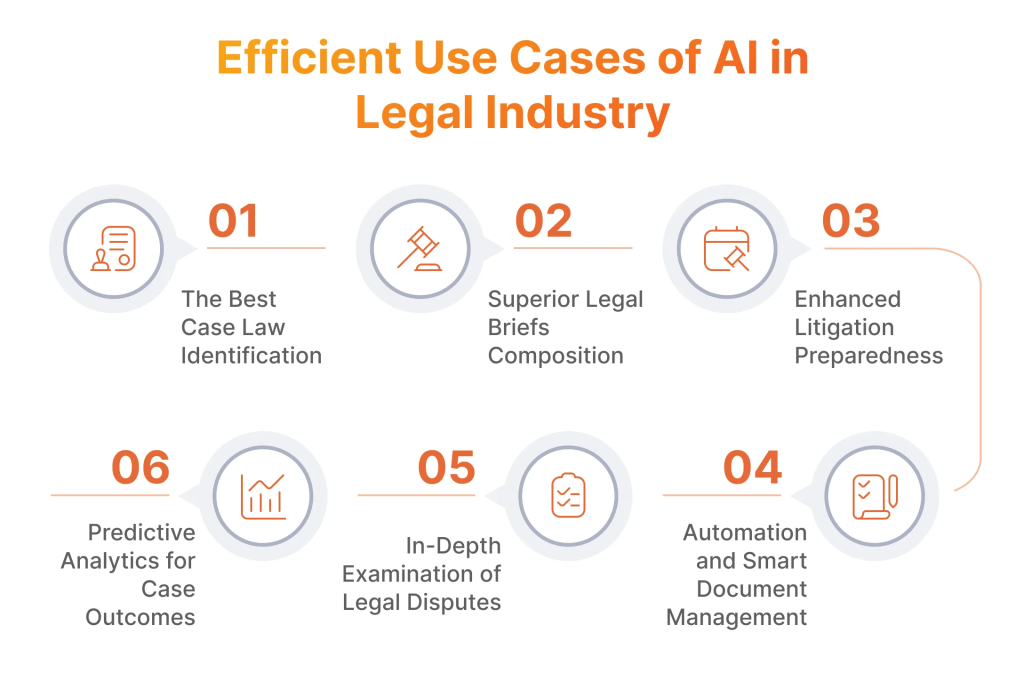
- Legal Research and Case Analysis: AI agents can quickly search through large databases of laws and past cases, giving lawyers the information they need to build stronger cases without spending hours.
- Contract Analysis and Review: In contract work, AI tools scan documents instantly, spotting important sections and flagging any risks. It makes the contract review process faster without compromising accuracy.
- Client Services and Chatbots: Beyond research, AI also supports client communication. Virtual assistants handle routine client questions and provide updates on cases. It allows law firms to respond quickly and keep clients satisfied.
- Compliance Monitoring: AI is also valuable in keeping up with changing laws. AI agents alert firms to new requirements by tracking regulatory updates, helping them stay compliant and avoid potential issues.
- Predictive Analytics for Case Outcomes: In case preparation, AI uses data from past cases to suggest likely outcomes. This gives lawyers an edge in planning strategies and helps clients understand potential results.
Did you know that a study found that an AI algorithm, developed by Michigan State University and South Texas College of Law, predicted 69% of U.S. Supreme Court decisions correctly, a rate higher than many expert predictions? (Check out the complete report here)
This suggests AI’s potential in predictive legal analytics, though it's more of an example of capability than a metric of current usage in law firms.
- eDiscovery: During case preparation, AI tools sift through large amounts of digital documents to locate relevant information, making it easier to build a strong case quickly and accurately.
- Due Diligence: For big transactions like mergers, AI can review documents, check for risks, ensure compliance speed up the process, and help firms avoid costly oversights.
- Legal Billing and Invoicing: AI also helps businesses by tracking hours, and automating invoicing, making billing more accurate and less time-consuming.
- Intellectual Property (IP) Management: Finally, AI supports intellectual property management by tracking deadlines, monitoring for any possible infringement, and keeping renewals on schedule to protect clients' rights.
To bring these applications to life, law firms can choose from several specialized AI tools designed to meet specific legal needs.
Here’s a look at some of the top AI agents transforming legal practice today.
7 Types of AI Agents with Examples and Use Cases
1. CodeConductor.AI
https://codeconductor.ai/wp-content/uploads/2024/08/CC-LP-Banner-Video-1.mp4
- Use Case: Document management and workflow automation
- Overview: CodeConductor is a powerful AI-driven tool tailored specifically for the legal industry. It offers advanced document management capabilities and automates time-consuming tasks like contract review and document classification. With customizable workflows, enhanced team collaboration, and strong security protocols, CodeConductor helps law firms streamline operations, improve efficiency, and maintain compliance—all while securely managing high volumes of legal data.
2. Kira Systems
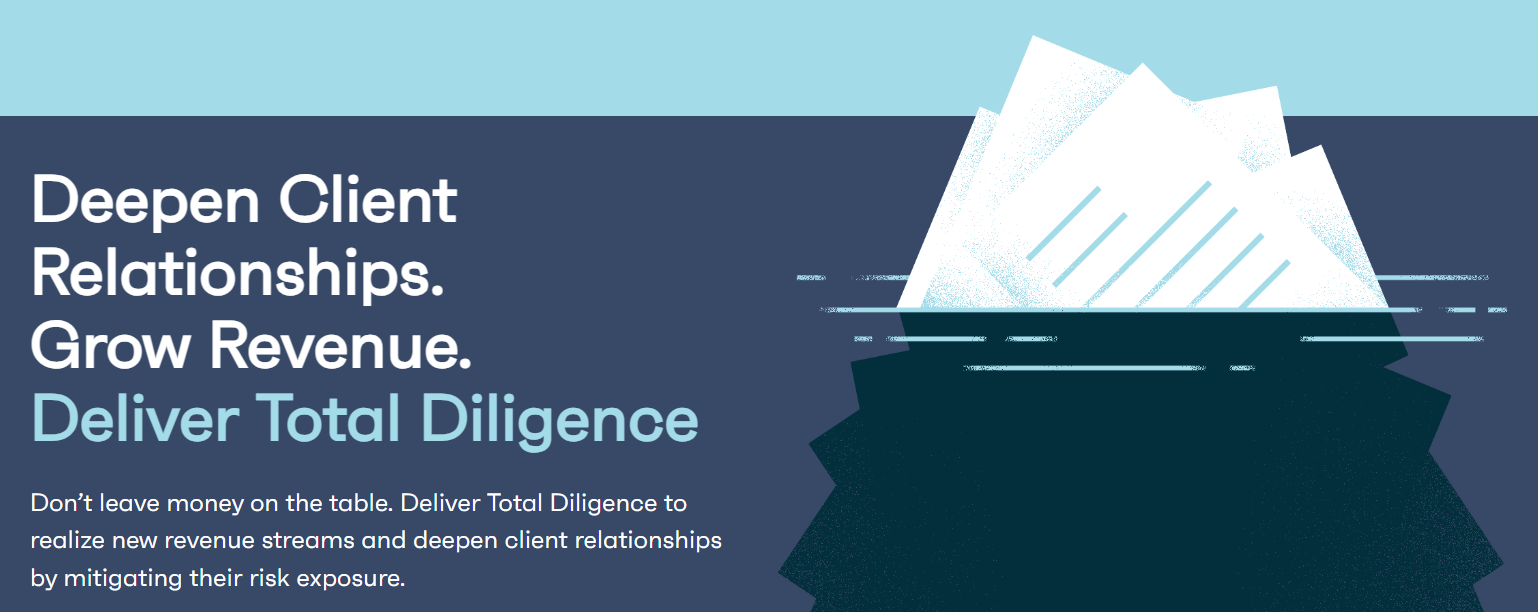
- Use Case: Contract analysis and due diligence
- Overview: Kira Systems is designed for rapid contract review and analysis, identifying key clauses, terms, and obligations. Ideal for due diligence in mergers and acquisitions, Kira Systems reduces the time lawyers spend on manual document review.
3. ROSS Intelligence
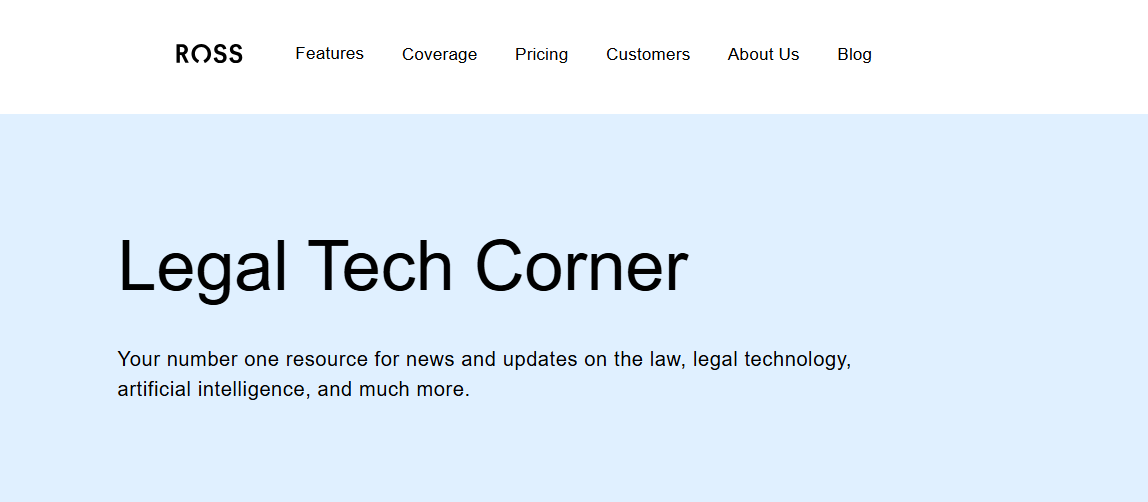
- Use Case: Legal research
- Overview: ROSS Intelligence, powered by IBM’s Watson, uses natural language processing to help lawyers locate case law, statutes, and legal opinions. Lawyers can ask questions in plain English and get precise, relevant answers.
4. Spellbook

- Use Case: Contract drafting and analysis
- Overview: Spellbook leverages AI to draft, review, and suggest contract improvements. It helps lawyers identify potential risks and inconsistencies in legal documents, which speeds up the document preparation process.
5. LawGeex
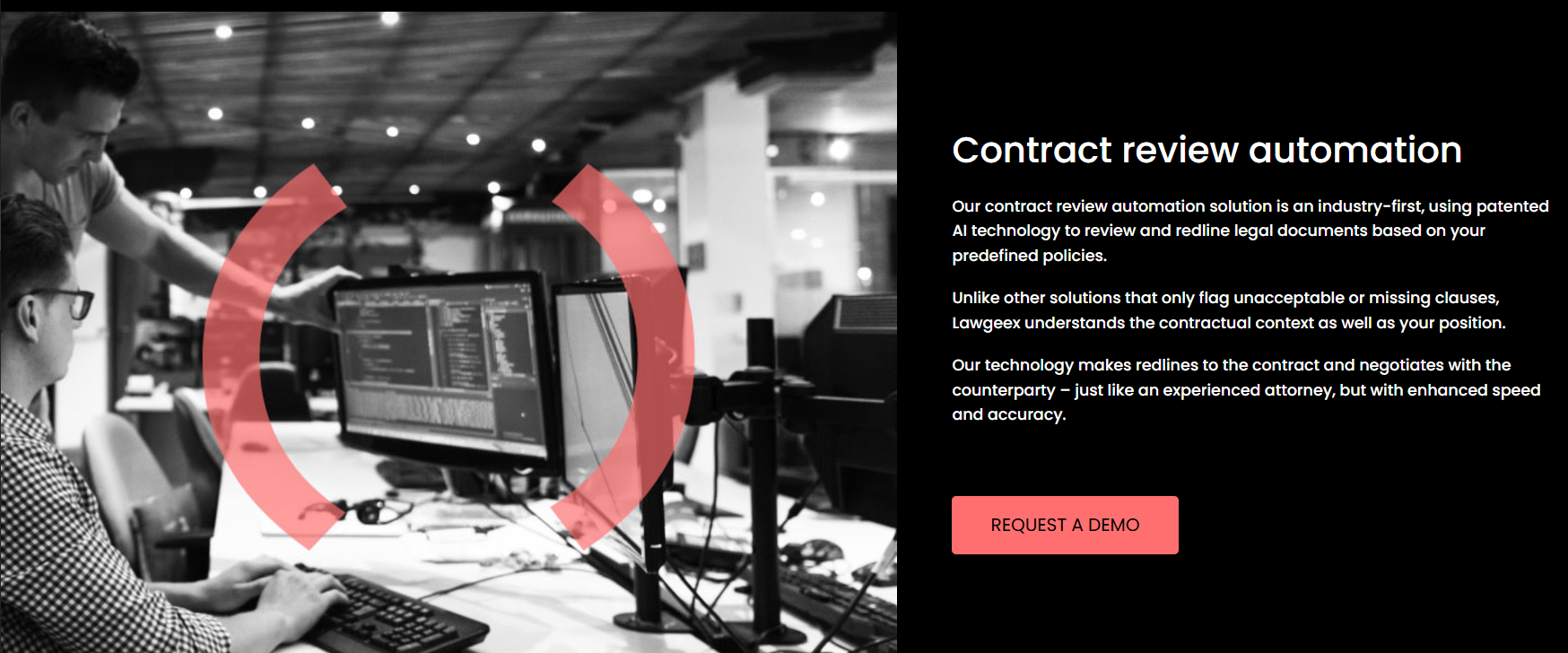
- Use Case: Contract review and compliance
- Overview: LawGeex automates contract review against predefined legal standards, ensuring compliance and reducing review time. Lawyers can focus on higher-level work while LawGeex handles routine contract analysis.
6. Luminance
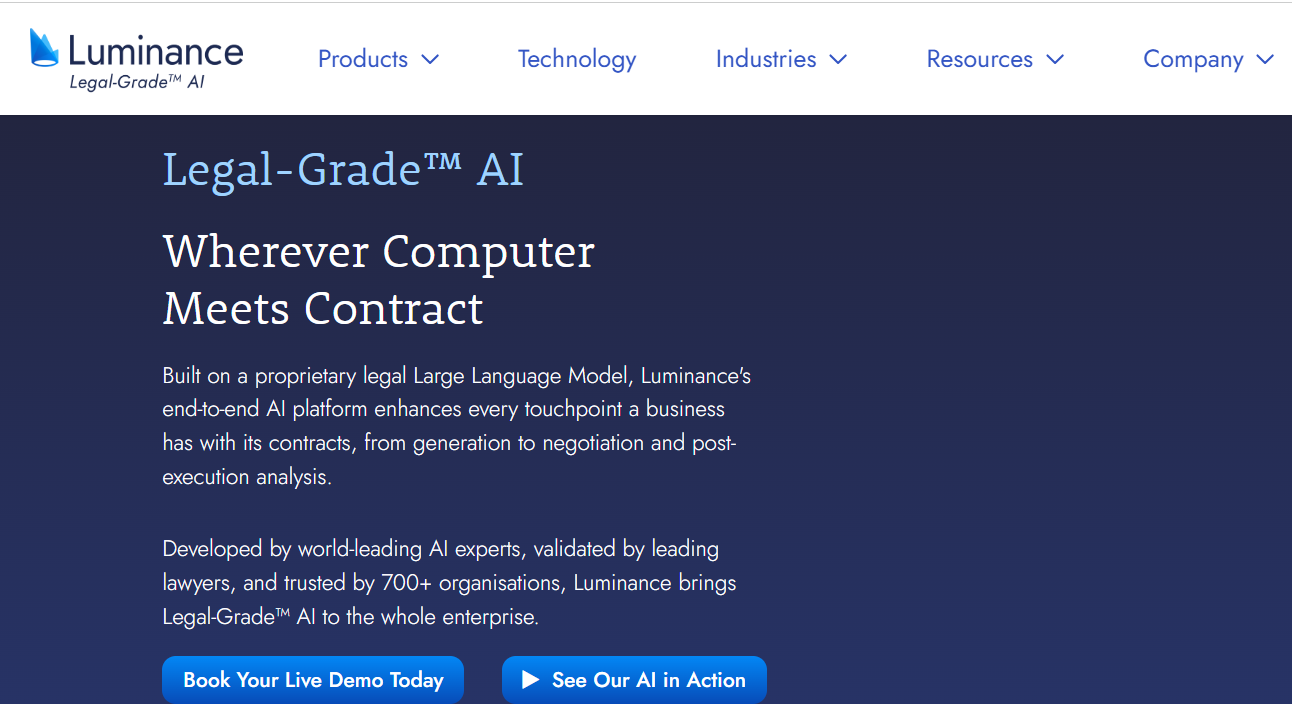
- Use Case: Document review and eDiscovery
- Overview: Luminance uses machine learning for document review, particularly in eDiscovery and compliance. It flags patterns, detects anomalies, and highlights key documents, making it ideal for handling large investigations.
7. Casetext’s CARA A.I.
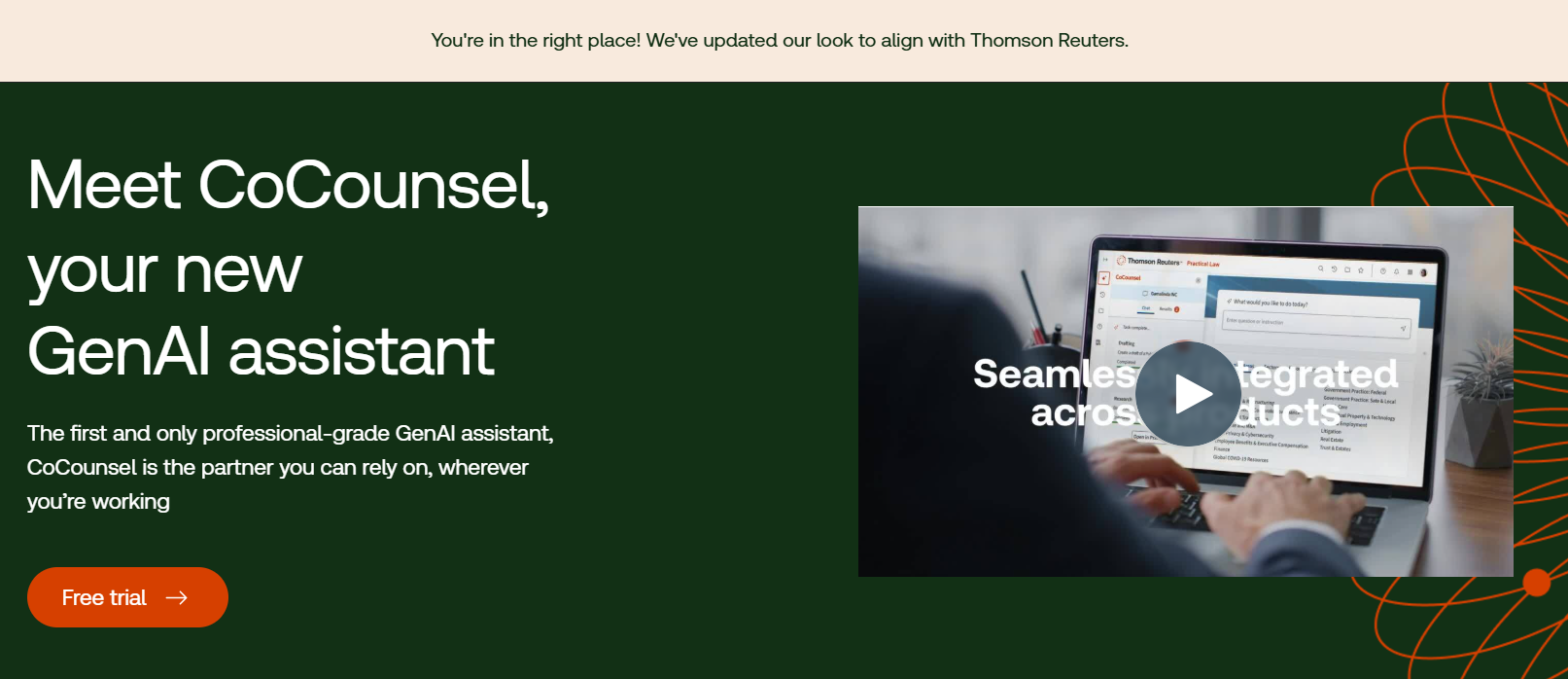
- Use Case: Case law research
- Overview: CARA A.I. by Casetext is a research tool that analyzes uploaded briefs and identifies relevant cases to strengthen arguments. It helps lawyers locate important precedents they might have missed.
By managing tasks like intelligent document search, risk assessment, and research, AI agents are helping law firms unlock a new level of precision and operational efficiency.
These AI assistants go beyond simple automation, offering cost savings, insightful data-driven support for decision-making, and the ability to scale services without adding to staff workloads. With their impact growing across these areas, AI agents are becoming an invaluable part of modern legal practice.
Let’s explore the key benefits of AI agents in law and see how they’re reshaping legal operations on numerous fronts.
Top Benefits of AI Agents for Lawyers
AI agents do more than speed up tasks—they’re changing the way law firms operate at a strategic level, offering benefits that support growth, client trust, and innovation.
Here are some of the top ways AI agents are making an impact:
- Strategic Resource Allocation: With AI handling routine, time-intensive tasks, legal teams can reallocate resources to areas that require human expertise, such as client relations, strategy development, and complex legal analysis. This shift allows law firms to focus more on high-impact work, increasing their productivity and effectiveness.
- Data-Driven Decision Support: By analyzing case patterns, trends, and historical data, AI agents offer insights that aid in critical decision-making. For example, when advising clients, lawyers can reference predictive analytics from AI to give more accurate assessments of likely case outcomes or risks, leading to better-informed strategies.
- Boosted Competitiveness and Innovation: Law firms that integrate AI agents effectively are at the forefront of legal technology. This improves their service quality and positions them as tech-savvy leaders, which can attract clients seeking modern, efficient legal solutions. Staying ahead with AI can be a key differentiator in a highly competitive industry.
- Increased Client Trust and Satisfaction: AI agents enable faster responses, real-time case updates, and enhanced data accuracy, which lead to a more transparent and reliable client experience. As a result, clients feel better informed and more involved in their legal matters, strengthening their trust in the firm.
- Risk Mitigation and Compliance Readiness: AI agents provide law firms with proactive compliance tracking and real-time regulatory alerts, ensuring that firms stay aligned with legal standards. This reduces the chance of costly errors or penalties related to non-compliance, giving firms a reputation for reliability and diligence.
- Scalable Solutions for Growth: AI agents allow law firms to handle larger caseloads and expand their services without proportionately increasing staff. With tools that adapt and scale to demand, firms can grow their client base or handle more complex cases without strain on resources.
- Long-Term Cost Efficiency: While AI technology requires an initial investment, the long-term cost benefits are significant. By reducing the need for additional administrative hiring and minimizing hours spent on repetitive tasks, AI agents help law firms achieve a leaner, more cost-efficient operation over time.
Incorporating AI agents allows law firms to enhance client service, build a future-ready practice, and optimize resources, all while maintaining a high standard of accuracy and compliance. These advantages make AI a strategic asset in modern law, supporting firms not only in what they do but in how effectively they deliver value.
With a clear understanding of the key benefits that AI agents bring to legal practices, law firms need to approach implementation thoughtfully to maximize these advantages.
However, successfully integrating AI into existing workflows requires careful planning and consideration of best practices.
Let’s explore some effective best practices for implementing AI agents in law firms.
Best Practices for Utilizing AI in Your Law Firm
Successfully integrating AI agents into a law firm’s operations involves several critical steps to ensure that the technology enhances workflows and provides maximum value. Here are some best practices to consider:
- Assess Firm Needs and Objectives: Law firms should assess their specific needs and objectives before implementing AI. Identify the areas where AI can have the most impact, whether in legal research, document review, or client management. Understanding the firm’s goals will help tailor the AI implementation process.
- Choose the Right AI Solutions: Not all AI tools are created equal. Select solutions that align with the firm’s specific requirements. and can seamlessly integrate with existing systems. Look for tools with strong track records in the legal field, good user reviews, and a clear understanding of legal processes.
- Engage Stakeholders Early: Involve key stakeholders, including lawyers, paralegals, and administrative staff, early in the implementation process. Gathering input and addressing concerns will foster a sense of ownership and increase the likelihood of successful adoption across the firm.
- Provide Comprehensive Training: To maximize the benefits of AI agents, offer thorough training sessions for all users. Familiarity with the technology will boost confidence and competence, allowing team members to effectively utilize AI tools in their daily tasks.
- Start with Pilot Projects: Instead of a full-scale rollout, consider starting with pilot projects to test the effectiveness of AI agents in specific areas of the firm. This approach allows for adjustments based on real-world use and feedback, making it easier to scale the implementation later.
- Monitor Performance and Gather Feedback: After implementation, continuously monitor the AI agents’ performance and gather feedback from users. This will help identify any issues, areas for improvement, and additional training needs, ensuring the tools are used to their full potential.
- Ensure Data Security and Compliance: As with any technology that handles sensitive information, it’s crucial to prioritize data security and compliance. Ensure that AI tools meet all relevant legal and ethical standards, protecting client confidentiality and firm data.
- Evaluate ROI and Adapt Over Time: Regularly assess the (ROI) of AI tools and their impact on firm operations. Adapt the use of AI agents as needed based on performance metrics and evolving firm needs to continually improve outcomes.
While AI is transforming legal work in amazing ways, it also comes with some important ethical considerations. Law firms must think carefully about these challenges to ensure they’re using AI responsibly.
Let’s explore them in detail:
Challenges and Considerations of AI in Law
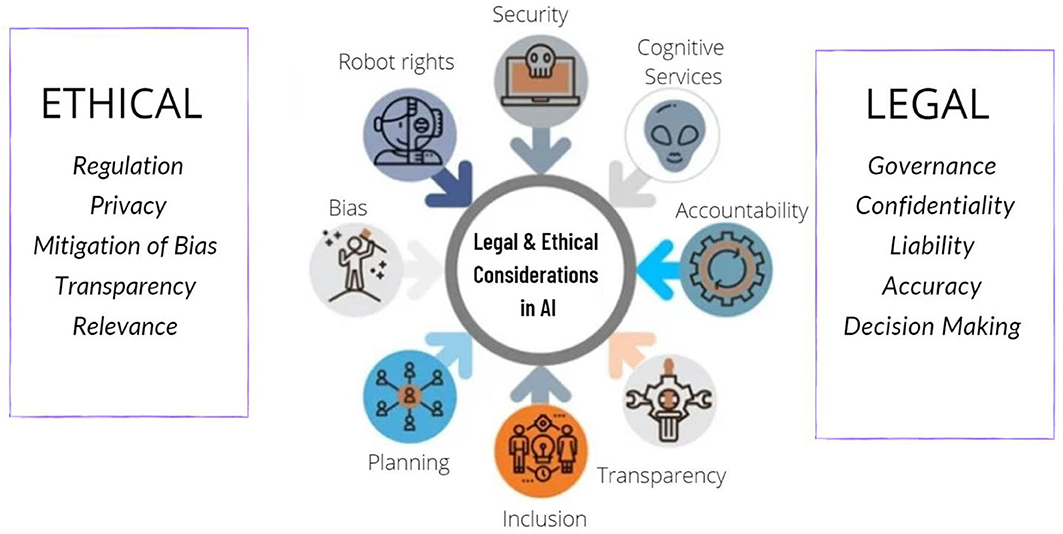
- Keeping Client Data Private: AI agents often handle a lot of sensitive information, like personal details and confidential case files. Protecting this data is essential, as a breach could lead to major legal and ethical issues. Law firms should choose AI tools with strong security measures, like encryption, and regularly update their data security practices to keep everything safe.
- Addressing Bias and Fairness: Believe it or not, AI can sometimes carry biases, especially if the data it was trained on has certain patterns or past biases. This can unintentionally lead to unfair outcomes, like skewed risk assessments or case predictions. To prevent this, law firms need to work with AI providers who are transparent about how they gather data and who routinely test their systems for fairness.
- Ensuring Transparency: AI can feel like a bit of a “black box”—it can make decisions, but users might not fully understand how it got there. In law, where transparency is key, this can be a problem. Using “explainable AI tools” can help. They provide insight into the AI’s decision-making process, allowing firms to be more accountable and reliable in their practices.
- Knowing AI’s Limits: AI agents are excellent with data but lack the nuanced judgment that lawyers bring to the table.
Complex cases or ethical decisions often require human insight, and this is where AI should step back. Setting clear limits on where AI is used—such as in research or document review—and where lawyers need to take the lead can ensure that each case gets the right level of care and expertise.
- Being Upfront with Clients: If it is about the client case, being transparent about AI’s role can help build trust. Clients should have the option to ask for human help if they’re more comfortable with it. This openness keeps clients informed and confident in how their cases are being managed.
- Respecting Sensitivity in Certain Cases: Some cases, especially those in family law or criminal defense, require a more personal touch. Relying too heavily on AI in these situations could take away from the sensitivity these cases need.
Law firms should have guidelines to decide when AI is appropriate and when a hands-on, human approach is better suited.
By staying aware of these ethical concerns, law firms can use AI in a way that’s beneficial and responsible.
With thoughtful guidelines, strong data protection, and clear communication with clients, firms can balance AI’s advantages with a commitment to high ethical standards.
People Also Ask - Artificial Intelligence Agents in Legal
- How does AI enhance efficiency in legal research?
- AI expedites legal research by swiftly analyzing vast legal databases, enabling lawyers to access pertinent information more rapidly and accurately.
- In what ways does AI improve contract analysis?
- AI streamlines contract analysis by quickly identifying key clauses and potential risks, thereby reducing the time and effort required for manual review.
- How does AI contribute to cost savings for law firms?
- By automating routine tasks, AI allows law firms to allocate resources more effectively, leading to significant cost reductions and increased profitability.
- Can AI assist in predicting legal outcomes?
- Yes, AI utilizes predictive analytics to assess case outcomes based on historical data, aiding lawyers in formulating more effective legal strategies.
- How does AI enhance client service in law firms?
- AI-powered tools facilitate faster response times and personalized client interactions, thereby improving overall client satisfaction and engagement.
- What role does AI play in due diligence processes?
- AI accelerates due diligence by efficiently reviewing and analyzing large volumes of documents, ensuring thoroughness and accuracy in legal transactions.
- How does AI support compliance monitoring?
- AI systems continuously monitor regulatory changes, helping law firms remain compliant with evolving laws and reducing the risk of legal penalties.
- Can AI improve the accuracy of legal document drafting?
- Yes, AI assists in drafting legal documents by suggesting standard clauses and identifying inconsistencies, enhancing accuracy and efficiency.
- How does AI facilitate eDiscovery in legal cases?
- AI streamlines eDiscovery by quickly sifting through electronic data to identify relevant information, expediting the litigation process.
- What impact does AI have on legal billing processes?
- AI automates billing by accurately tracking billable hours and generating invoices, reducing administrative burdens and improving financial management.
Conclusion
AI agents are transforming the legal industry, offering law firms new ways to work smarter, serve clients better, and stay competitive. From reducing time spent on repetitive tasks to enhancing decision-making, AI brings a lot to the table—but it’s important to implement these tools thoughtfully, with a strong focus on ethics and client trust.
If your firm is interested in exploring how AI could make a real difference in your day-to-day operations, it might be time to connect with experts who understand the unique needs of the legal world. RedBlink Technologies offers customized AI solutions for law firms, helping you navigate everything from data security to compliance and client-focused applications.
Curious about what AI could do for your law firm? Visit RedBlink Technologies to learn more, or feel free to reach out and see how their solutions might fit into your vision for a modern, efficient practice.
Go-to-market ( GTM ) Frameworks for Killer GTM Strategy [2025]
However, GTM strategy is a set of activities that will propel your product to the scaling stage. The holy grail is to find at least one repeatable and scalable GTM motion that will drive your growth.
In this article, I will present three frameworks that will help you make your GTM journey faster and with less risk of failure. They are based on more than 12 years of my experience, having worked with more than 650 teams of different sizes and from various industries — including Fortune 500 companies.
Understanding the Three Phases of Go-To-Market (GTM) Alignment

The go-to-market (GTM) journey can be divided into three core milestones before you can start efficiently scaling:
- Stage 1: Problem-Solution Fit. OK, you have done the discovery stage and found evidence that your product actually solves the problem. You have up to five paid customers — nascent product-market fit (customers from your rolodex and social networks). You are ready to continue your journey.
- Stage 2: Product-Market Fit. You start building a sustainable business model. The prerequisite is retention — that your customers return to the product and regularly use it. Not only can your product deliver value to the customer, but you can also capture some of the value to build a sustainable business. Call me strange for thinking that making money is important, especially if you are bootstrapping or operating within very limited resources 🤷
- Stage 3: Go-to-Market Fit. Find at least one go-to-market motion — a predictable and scalable way to attract customers to your product so that later on you can find more product-market fits (open new markets). These are the most common GTM Motions in the tech industry and for SaaS products . If there is something else working predictably well for you (retail marketing, events…), consider adding your choices to this list.

After you understand the core milestones, let’s step up the game with three mission-critical concepts that will more likely than not emerge on your go-to-market journey. I will help you explain these concepts by offering examples from the real company’s go-to-market journey and equip you with frameworks that will help you solve this dilemma with confidence (and for confidence, we need evidence - proof that something is working).
Framework #1: Crafting an Initial Customer Profile (ICP) as a Precursor to Your Ideal Customer Profile
Often, teams start their “persona seeking” journey with a brainstorming exercise. As the outcome, they would define how Hans from Germany who drives Volkswagen and loves to ski is their Ideal Customer Profile (ICP). This is irrelevant if you are not selling Volkswagen accessories or skis. To avoid BS personas, you need to do a much better job in customer discovery, centering on jobs to be done. If you are selling to B2B, there is usually not one persona, but you need to understand the buying committee —a decision-making unit.
Many of you already know this and have done a fine job in defining ICP - but here is the trick: In the early stages of Go-to-Market journey, your ICP will require evidence (case studies, references, testimonials, compliance certifications and other “confidence boosters”) before happily taking your product for a spin.
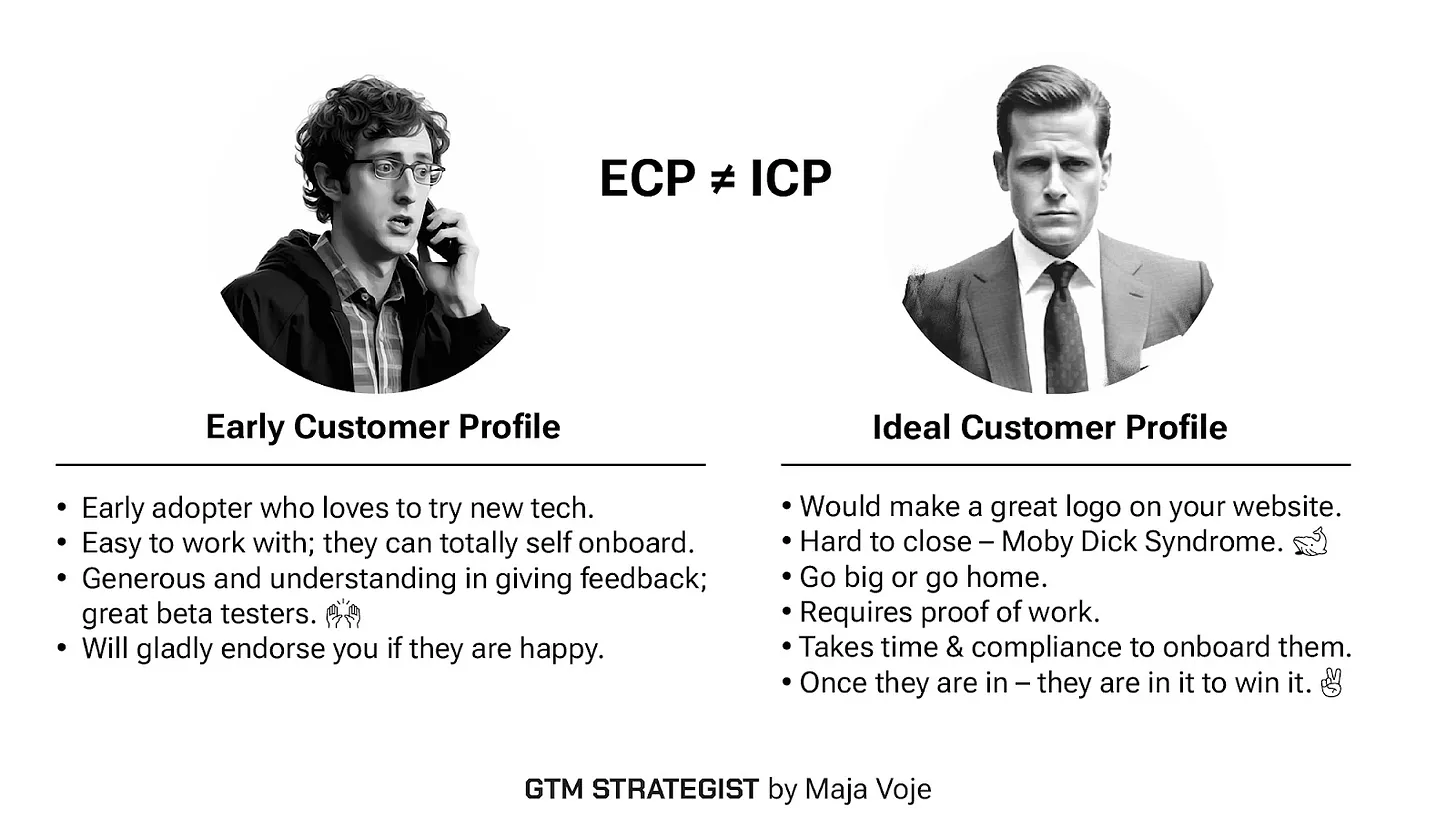
Here is when Early Customer Profile (ECP) kicks in. Instead of going around chasing references from all fields of life and trapping yourself in 6-18 months sales cycles, you should rather sit down, crunch some data, talk to users, and find a segment that will have:
- Burning pain point, aka the urgency to solve this problem now.
- Proven willingness to pay. last time I checked, product love alone does not keep the office lights on. You need to capture some of the value you created to pay your bills.
- Serve as a good reference and is willing to recommend your solution to peers.
- Proximity to you where you can actually reach them and strike a deal in a reasonable time.
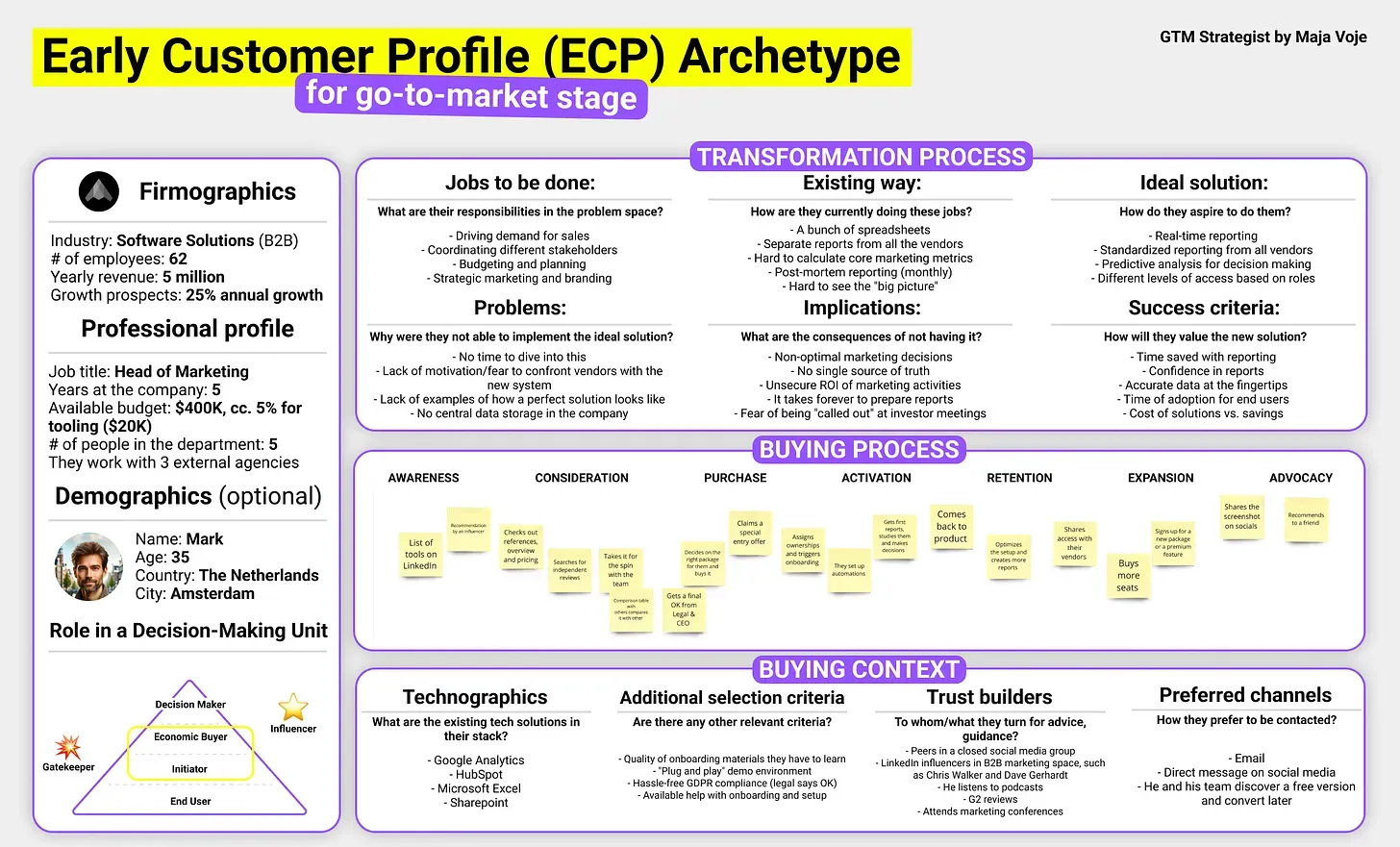
Framework you can use to define your ECP
This is why in the problem-solution fit stage, your first customers usually come from your contact lists, VCs or advisors. More likely than not, you will have to work your way up to the ICP by securing relevant pilot projects, case studies and references that will get you foot in the door of your ICP’s fortress.
Example: DevStats is a data visualization and goal-setting tool that helps engineering leaders improve the efficiency of their teams and plan better. It connects with tools such as Jira, Github and others, which are super heavy in terms of IP.
Since many bigger teams (ICP) and teams from more data sensitive areas (pharma, medical, finance, etc.) require SOC security certifications and lots of evidence and proof that the tool will “pass their compliance”, the early customer profiles (ECP) in the next 3-6 months are teams up to 30 engineers that can make more autonomous decisions about the tooling.
Framework #2: Building Distinctive Positioning through a Strong Value and Sales Proposition
Days of being something like an “AI-powered decentralized all-in-one CRM solution for businesses” are over.
As the market entry barriers are lower than ever and customers are getting immune to generic pitches craving the “what is in it for them” epiphany in a nutshell, positioning is more important than ever.
In simple words: sometimes the only way to stand out as a new player on the market is to communicate 10x value compared to existing solutions for your target customers. Most companies cannot really compete on price in the long-term (economies of scale are hard to achieve) and, ultimately, there can only be one cheapest player on the market. It is the race to the bottom. Break their inertia and reluctance to implement changes with differentiated positioning.
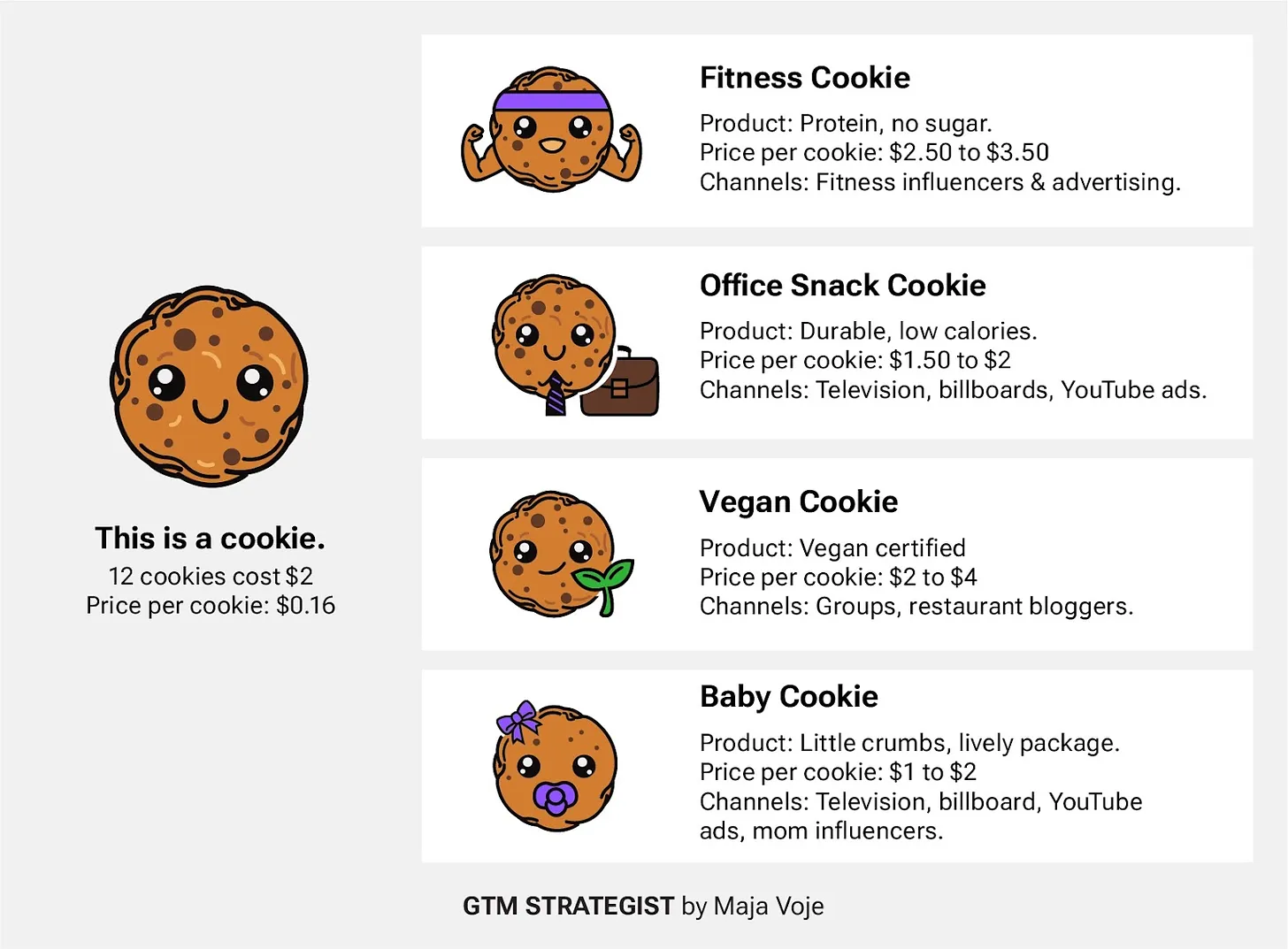
Your job to be done here is to develop a differentiated positioning:
- Define your UVP (unique value propositions) aka your promise to the customer
- Develop convincing USPs (unique selling propositions) aka why are you the go-to choice for your ICP? How are you different/better than competitive alternatives?
Here is the key 🔑: you always position in relation to something. That something can be a service, DIY process, doing nothing, direct competitors, or even something that your potential users tweaked in Excel.
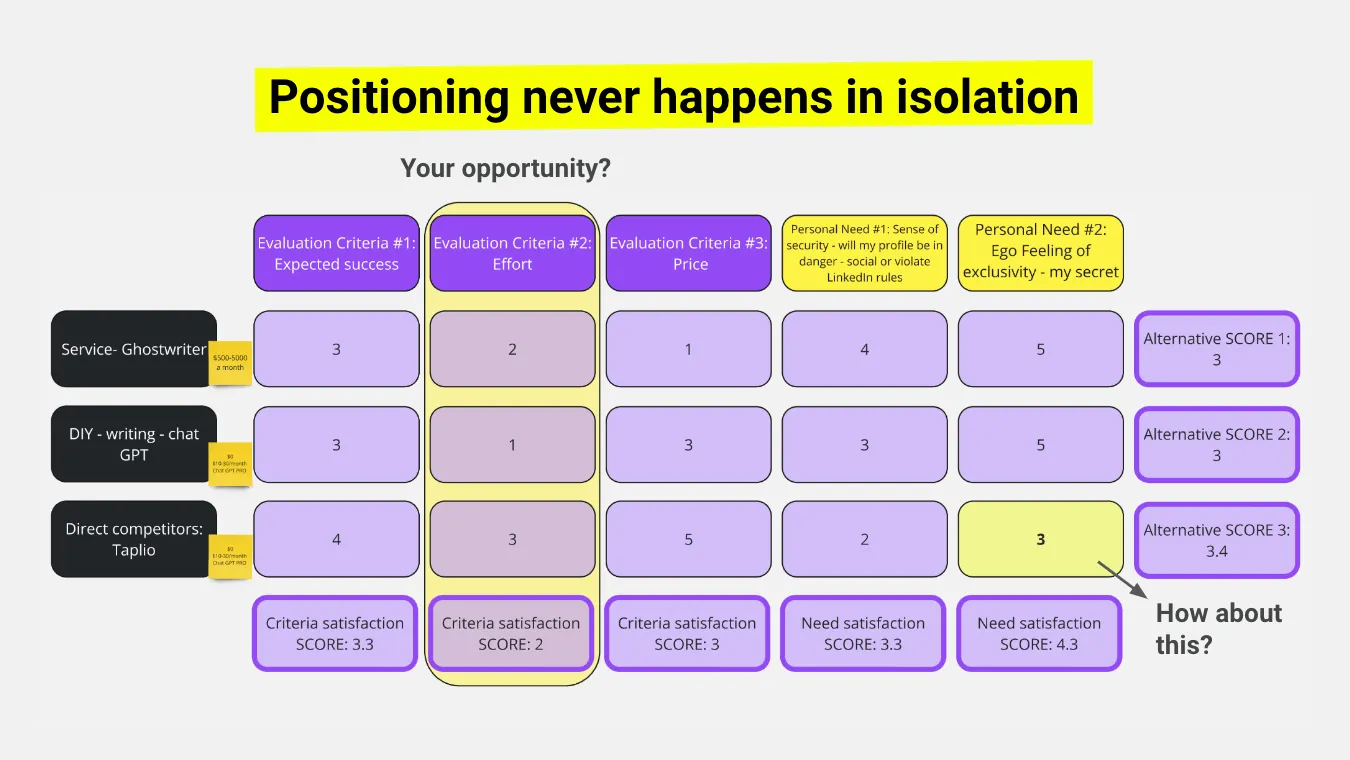
Start by understanding the competitive alternatives — how your target customer is currently solving the problem. Next in line is understanding the evaluation criteria — what is important to the customers when making this decision and comparing alternatives. Bring all the elements together and score — how good is a certain competitive alternative in solving this problem?
You will either find evaluation criteria or competitors that will give you a fair fighting chance where you can thrive on the market. Choose your battles and play on your strengths. These are always the pillars of a winning strategy.
Example: Post Rewriter is an AI copywriting tool that competes against ghostwriters on LinkedIn as well as DIY solutions (aka Claude, ChatGPT) and other automation tools (direct competitors). It turns out the criteria to compete is “ease of use” so we went ahead, tested and validated such messaging:
- UVP: Turn your unique thoughts into a successful LinkedIn post while you have a coffee - for better copywriting
- USP1: Trained on 60K+ viral LinkedIn posts curated by a copywriter who made $5 million for his clients (+33% reach)
- USP2: No one will know that you use a shortcut
- USP3: Safe to use — not a LinkedIn integration that could jeopardize your profile
Thanks for reading Growth Unhinged! Support my work by subscribing, liking and sharing.
Framework #3: Structuring a GTM Blueprint to Drive Sustainable Growth within Budget
After you’ve determined your target audience and messaging, it’s time to get users into your product. Here’s where GTM motions come into play, and innovative tools like CodeConductor.ai can significantly simplify this phase. Code Conductor enables you to skip the coding hassle by transforming ideas into full-scale applications in as little as 60 minutes. This AI-driven platform handles the heavy lifting, from building to deployment, freeing your team to focus on strategic growth initiatives rather than technical setup.
CodeConductor platform supports scalability and freedom from platform lock-ins, so you can deploy your applications on various environments like VMs, Kubernetes, or any cloud service provider. By leveraging CodeConductor, you gain agility in your GTM execution, avoiding the resource-intensive bottlenecks of traditional app development.
As you refine your GTM motions with proven tools and frameworks, you’ll be better equipped to scale customer acquisition sustainably and cost-effectively.
Example: AI-enabled B2B influencer marketing platform Expert9 is on a mission to get 1,000 users, 200 weekly active users and 10 paying customers with $0. What should they do? Here is the plan!
- Step 1: Tap their personal network to get first 10 case studies of brand collaborations.
- Step 2: Present these case studies and create content on LinkedIn, then send outbound messages to their ICP to secure first 5 customers. Booster: It will help if they eat their dog food — work with influencers.
- Step 3: Now, how to scale from 5 to 50 brands that will work with influencers is the real question to handle. From their early validation, their first GTM motions will most likely be outbound (sending out emails and DMs on LinkedIn to CMOs and heads of growth), inbound (content creations and collaborations) and partnerships (with agencies for reselling, exclusive deals with influencers and brands).
I use “GTM Power Hour” framework with my teams to define objectives and plan for the next period. You can grab the template in Miro here.
Product-Market Fit (PMF): A Continuous Journey, Not a One-Time Achievement
I like to think of PMF as a cycle. Most companies take five to seven spins to align all the elements. Every time I fail to validate something, I remember that Nokia started with toilet paper, Lamborghini with tractors, and McDonald’s with hot dogs.
The faster we spin it, the more likely we are to be the lucky one to cross the chasm. So let it spin.
Coming up with assumptions, testing, analyzing, and iterating is the best way to align all the moving parts of PMF and GTM motions. It does not have to be magic ✨, use the scientific method, look at the numbers and test hypotheses 🤠
Good luck on your go-to-market journey. I am cheering for you!
Artificial Intelligence Outlook - Trends, Investments & Policies
Introduction
Artificial intelligence (AI) is rapidly transforming industries, catalyzing unprecedented levels of investment, and prompting policymakers worldwide to establish new frameworks for its regulation. In 2024, AI saw extraordinary growth in venture and private equity funding, with generative AI leading the charge. As we look toward 2025, understanding the investment trends, sectoral impacts, and emerging policies that shape AI's trajectory is essential for navigating this dynamic landscape.
This guide provides a deep dive into AI’s major areas of influence, from healthcare innovations to legal tech, outlining the investments, transformations, and regulatory considerations shaping the AI landscape in 2025.
AI Investment Landscape in 2025
2024 marked a pivotal year for AI investment, with generative AI drawing immense venture capital attention. Generative AI funding skyrocketed, reaching over $50 billion, a fivefold increase from 2023. Foundational technologies, including model training and high-performance computing, received substantial backing as they enable transformative AI applications across sectors.
Why It Matters: Generative AI models are not just tools but foundational innovations. Investments here signify a shift towards systems capable of creating content, analyzing vast data, and performing tasks with minimal human intervention. This focus on foundational AI highlights the industry's intent to harness AI’s creative and analytical potential to its fullest extent.
Key Takeaway: Generative AI’s substantial funding underlines its central role in future technological ecosystems, from digital assistants to automated content generation and beyond.
Key AI Investment Trends and Figures
- Generative AI Investment Surge: Venture funding for AI in 2023 reached over $50 billion, with generative AI specifically seeing a fivefold increase in investment compared to 2022. Private equity (PE) investments in generative AI also saw a sharp rise, moving from $1 billion in 2022 to $2.2 billion in 2023, with nearly half of this concentrated in the third quarter.
- Top Funding Rounds: Significant investment has centered on notable generative AI startups like OpenAI, Inflection AI, Anthropic, Databricks, and Aleph Alpha, which collectively raised over $14 billion. This highlights the industry’s focus on foundational AI companies expected to drive transformative changes.
- Impact on Sectors: Investment opportunities are expanding into sectors like fintech, health tech, retail, and climate tech, where AI can boost operational efficiency. This trend points to the broader adoption of AI tools across industries
The Role of AI in Dealmaking and M&A
AI is redefining dealmaking, from sourcing to due diligence in venture capital, private equity, and mergers & acquisitions (M&A). In 2023, only 16% of dealmakers used AI in M&A processes, but this number is projected to reach 80% by 2025. AI-driven platforms streamline the identification of investment opportunities, facilitate data analysis, and improve accuracy in contract reviews.
- Why It Matters: In highly competitive fields like VC, PE, and M&A, AI's efficiency in processing and analyzing data offers a significant edge. Early adopters of AI in dealmaking are poised to gain a substantial competitive advantage.
- Key Takeaway: AI in dealmaking is moving from a novelty to a necessity, providing firms with the tools they need to streamline processes and gain an edge over competitors.
Policy and Regulatory Developments in AI
U.S. AI Policy Landscape - In the U.S., policy is evolving to balance AI innovation with responsible oversight. The Future of AI Innovation Act, which recently passed the Senate Commerce Committee, highlights the growing effort to support safe AI development. Vice President Kamala Harris, tasked with overseeing AI policy, aims to foster international cooperation on ethical AI standards, underscoring a commitment to a responsible innovation ecosystem.
- Why It Matters: Policies that promote innovation while safeguarding ethical standards are essential to AI’s sustainable growth. The U.S. government's approach, focusing on both encouragement and regulation, reflects a maturing stance on AI’s societal impact.
- Key Takeaway: The U.S. is advancing policies that support ethical AI, aiming to foster a regulatory framework that protects users while encouraging innovation.
International AI Policy Trends
Countries worldwide are addressing AI’s impact, balancing innovation with ethical standards. The European Union has led the way with strict AI policies, including guidelines on transparency and bias reduction. International AI agreements are also being considered to set a global standard for AI usage and development.
- Why It Matters: With AI impacting multiple domains, international policy alignment is crucial. Standardized ethical guidelines can prevent AI misuse while enabling cross-border collaboration on technological advancements.
- Key Takeaway: As AI adoption grows globally, international cooperation will help establish standardized guidelines for responsible AI use.
Strategic Forecasts for AI in 2025 and Beyond
Focus on Foundational AI Technology - Investments in foundational AI infrastructure are expected to continue, including in high-performance semiconductors, model training, and climate-friendly power solutions. This foundational approach, mirroring the early phases of electrification, emphasizes the infrastructure needed for AI to thrive and create broad technological advances.
- Why It Matters: By focusing on foundational technologies, investors are building the backbone for future AI applications, ensuring the scalability and sustainability of AI innovations.
- Key Takeaway: Foundational AI investments today are setting the stage for the broader adoption and innovation in AI applications tomorrow.
Evolving Valuations and Market Correction
With regulatory frameworks emerging, the initial "Wild West" phase of AI investment is expected to stabilize. This shift could lead to more structured valuations and investment guidelines, reducing the volatility currently associated with AI ventures.
- Why It Matters: Structured valuations and market corrections will bring stability to AI investments, allowing investors to make more informed decisions while fostering sustainable growth in the AI sector.
- Key Takeaway: A maturing AI market with clearer regulatory guardrails is likely to create a more stable and attractive investment landscape.
Emerging AI Use Cases Across Industries
1. AI in Manufacturing and Automation
Overview: AI is transforming manufacturing by enabling predictive maintenance, quality control, and process automation. Tools powered by machine learning can analyze vast datasets from equipment sensors to predict when maintenance is needed, reducing downtime. In production lines, AI-powered robots are automating complex assembly processes, ensuring high precision and consistency.
Key Tools
- Avathon: An AI-driven tool that focuses on predictive maintenance, helping manufacturers prevent equipment failures by analyzing sensor data.
- Bright Machines: A platform that automates repetitive tasks in manufacturing using robotics and AI, allowing for greater efficiency and consistency in production.
- Sight Machine: A real-time manufacturing data platform that analyzes and improves factory performance, optimizing production and quality control.
- Why It Matters: AI-driven automation enables manufacturers to increase efficiency, reduce costs, and improve product quality. Predictive analytics and real-time monitoring align manufacturing with Industry 4.0 standards, ensuring competitiveness in a global market.
- Key Takeaway: AI in manufacturing is enabling companies to enhance productivity and ensure consistent product quality through advanced tools and automation.
2. AI in Education and E-Learning
Overview: AI’s role in education is growing, with tools that create adaptive learning experiences, automate grading, and provide real-time feedback to students. Personalized learning platforms use AI to adjust content based on individual progress, helping improve knowledge retention and engagement.
Key Tools
- Squirrel AI: An adaptive learning platform that uses AI to customize learning experiences for students, ensuring a personalized approach to education.
- Gradescope: An AI-based tool that assists in grading, making it faster and more efficient, especially in large-scale classrooms.
- Knewton: A learning platform that uses AI to offer adaptive, individualized content recommendations based on each student’s learning path and performance.
- Why It Matters: AI-powered tools in education make learning more accessible and adaptable, catering to diverse learning styles. With the rise of remote and hybrid models, AI is playing a crucial role in enhancing educational experiences.
- Key Takeaway: AI in education creates personalized and efficient learning environments, making education more engaging and inclusive for all learners.
3. AI in Healthcare and Medical Diagnostics
Overview: AI’s potential in healthcare is vast, from improving diagnostics to automating documentation. AI-powered tools in diagnostics analyze patient data to detect diseases early, while in clinical settings, AI assists with administrative tasks, allowing healthcare professionals to focus more on patient care.
Key Tools
- IBM Watson Health: A platform that leverages AI to assist in diagnostics and provide treatment recommendations, particularly for cancer and rare diseases.
- Zebra Medical Vision: Uses AI to analyze medical imaging, helping radiologists detect conditions like cancer, liver disease, and cardiovascular issues.
- Abridge: An AI-based tool that functions as a clinical scribe, automatically documenting patient interactions and reducing the administrative load on healthcare providers.
- Why It Matters: AI in healthcare improves patient outcomes by enhancing diagnostic accuracy and reducing administrative tasks. This advancement allows healthcare professionals to devote more time to patient care, ultimately benefiting the healthcare system.
- Key Takeaway: With AI, healthcare can become more efficient, accurate, and personalized, transforming patient care standards.
4. AI in Retail and Supply Chain Management
Overview: AI optimizes retail and supply chain processes by enhancing inventory management, predicting demand, and improving customer experiences. Tools like AI-driven inventory monitoring and demand forecasting help retailers meet customer needs more effectively and reduce wastage.
Key Tools
- Gather AI: A drone-powered inventory monitoring tool that uses AI to track stock in warehouses, reducing the need for manual inventory checks.
- Reflexis: An AI-based tool that assists retailers with workforce management, task scheduling, and labor optimization.
- ClearMetal: A predictive supply chain platform that uses AI to forecast demand and manage logistics, helping to optimize inventory levels and reduce costs.
- Why It Matters: AI innovations in retail and supply chain improve efficiency, cut costs, and enable businesses to respond quickly to market changes, enhancing customer satisfaction.
- Key Takeaway: AI is reshaping retail and supply chain management, making operations faster, more accurate, and responsive to demand.
5. AI in Legal and Financial Services
Overview: In legal and finance, AI automates tasks such as document review, legal research, and fraud detection. These AI-powered tools save time, reduce human error, and help professionals focus on high-value work.
Key Tools
- Casetext: An AI-powered legal research tool that provides quick access to relevant case law, statutes, and regulations, saving lawyers significant time.
- Ayasdi: A financial services AI platform that assists with fraud detection, anti-money laundering, and compliance.
- Kira Systems: An AI tool for contract review and analysis, automating the process of identifying critical clauses and reducing manual review time.
- Why It Matters: AI-driven tools in legal and finance provide significant time savings, increase operational accuracy, and reduce human error, making services more efficient and compliant.
- Key Takeaway: AI in legal and financial services automates labor-intensive tasks, allowing professionals to focus on strategic decision-making and client service.
6. AI in Environmental and Climate Monitoring
Overview: AI is increasingly used in environmental monitoring, helping organizations track deforestation, analyze water quality, and manage agricultural resources more effectively. Machine learning models process large data sets from satellites and IoT sensors to provide actionable insights for conservation efforts.
Key Tools
- Descartes Labs: Uses AI to analyze satellite imagery, tracking deforestation, crop health, and resource usage on a global scale.
- PlanetWatchers: An AI platform specializing in environmental monitoring, including forest management and agricultural land use.
- aWhere: A climate and agricultural data platform that uses AI to help farmers optimize resource use, based on local environmental data.
- Why It Matters: AI’s role in environmental monitoring enables timely insights and decision-making, critical for managing resources sustainably and addressing environmental challenges.
- Key Takeaway: AI-driven environmental tools support climate action by providing insights that help conserve resources, reduce waste, and protect natural ecosystems.
7. AI-Powered Renewable Energy Solutions
Overview: AI optimizes renewable energy production and distribution by analyzing patterns in energy demand and supply. It also enables more efficient energy grids by predicting fluctuations and adjusting power outputs accordingly.
Key Tools
- AutoGrid: An AI platform that provides predictive analytics and controls for energy providers, optimizing grid management and renewable energy integration.
- Enel X: Uses AI to manage and optimize energy demand, helping businesses and utilities reduce energy consumption and integrate renewable sources.
- Sense: A smart home energy monitor that uses AI to track real-time energy usage, providing homeowners with insights to reduce energy waste.
- Why It Matters: AI in renewable energy makes energy consumption more efficient and sustainable. By integrating renewable sources, AI tools contribute to global sustainability goals.
- Key Takeaway: AI-powered solutions in renewable energy are essential for managing resources efficiently and meeting the growing demand for clean, sustainable energy.
AI-Driven Development Platforms: Accelerating Innovation and Efficiency
As AI continues transforming industries, there's an increasing demand for tools that simplify AI development, making advanced capabilities accessible even for teams without extensive technical expertise. Platforms like CodeConductor.ai are revolutionizing software and AI development by providing businesses, startups, and developers with an AI-powered solution that builds applications rapidly, cutting traditional development time by up to 80%.
- Why It Matters: CodeConductor aligns with the current trend of democratizing AI development. By automating backend structuring, data modeling, and app architecture, CodeConductor enables teams to deploy production-ready code quickly, allowing them to focus on strategic goals rather than technical bottlenecks. This platform empowers organizations to stay competitive in a fast-evolving AI landscape by accelerating time-to-market and reducing development costs, making it an ideal tool in industries embracing digital transformation.
- Key Takeaway: Platforms like this are crucial for businesses seeking to leverage AI without the high costs and complexity traditionally associated with development. By reducing technical overhead, these platforms help businesses adapt to the demands of an AI-driven future more efficiently and effectively.
Conclusion
AI's influence across sectors is accelerating, driven by a combination of technological advances, increased investment, and evolving policy frameworks. With healthcare, finance, and retail among the sectors leading AI adoption, the technology’s impact is set to redefine productivity and innovation standards.
However, as AI grows, so does the need for balanced regulation to protect users and ensure ethical development. By understanding the current investment trends, regulatory shifts, and industry-specific AI applications, stakeholders can navigate AI’s opportunities and challenges, helping shape a future that leverages AI’s potential for societal benefit.
Top 15 AI Customer Service Agents Your Business Need in 2025
Are you struggling to keep up with customers' growing demands or finding it challenging to provide consistent, quality customer support without stretching your team?
For business owners, customer service managers, and professionals, ensuring quick, efficient, and high-quality service is no longer a luxury—it’s essential. With AI in customer service, businesses can automate support tasks, reduce response times, and heighten customer satisfaction while minimizing operational costs.
Top AI customer service agents
The top AI agents for customer service in 2024 include CodeConductor, Freshdesk, Zendesk, Salesforce Einstein, ServiceNow, IBM Watson Assistant, and Microsoft Power Virtual Agents. Each AI solution enhances support with advanced features like predictive analytics, personalized insights, and automated query handling, transforming customer service efficiency. Lets dive into details below.
Did you know that in 2023, nearly 70% of customer service leaders reported AI had the most positive impact on resolution time, while 65% highlighted improvements in cost reduction and employee satisfaction? (Statista)
AI in Customer Service: The Future of Customer Satisfaction

Customer service AI agents will be reshaping support operations by taking over repetitive tasks, allowing your team to focus on complex, high-value customer interactions. Imagine a world where customers never have to wait in long queues, and customer service is available 24/7, even when your human agents are offline.
More than mere automation, AI-enabled customer service agents use machine learning and natural language processing to evolve with each interaction, creating personalized and meaningful experiences. For example, 60% of customer service teams in industries like energy, resources, and automotive reported using AI chatbot customer service solutions in 2023-24 to improve efficiency and satisfaction.
Advances in generative AI and voice-based AI are setting the stage for even more personalized and sophisticated customer support. Self-learning AI systems will soon be able to refine their responses independently, enhancing the AI-driven customer service experience. Future developments include:
- Generative AI for Deeper Engagement: AI agents will handle increasingly nuanced conversations, transforming customer service with hyper-personalization.
- Voice-Based AI Enhancements: For natural, conversational interactions, voice-enabled AI tools will further elevate the customer experience.
Businesses using AI in customer service can anticipate more intelligent and adaptable solutions, giving them a competitive edge.
Ai Customer Service Statistics
- $75 billion annual loss due to poor customer service: This figure comes from a 2018 report by NewVoiceMedia, which found that poor service experiences drive customers to switch brands, costing businesses approximately $75 billion annually. This amount represents lost revenue, switching costs, and customer churn impacts on growth and retention (Business Wire, Bloomfire).
- 78% of consumers abandoning transactions due to poor service: Poor customer experiences lead to direct transaction losses, with studies showing that customers are quick to abandon interactions with inadequate support (SmallBizTrends, Zippia).
- Customers are 4 times more likely to switch to competitors over service issues: Service-related issues are significantly more likely to drive customers to switch than issues related to product or price (SmallBizTrends).
- 86% of customers willing to pay more for better service: This high percentage of consumers who value service reflects a general willingness to pay for improved experiences, as found in multiple studies (Forbes, Open Access BPO).
- Discrepancy between company perception and customer reality in service quality (80% vs. 8%): Bain & Company reported a gap between how companies perceive their service excellence and actual customer satisfaction levels, where only 8% of customers believe they experience superior service compared to 80% of companies believing they provide it.
- Positive experiences lead to 5 times higher recommendation likelihood: Satisfied customers are five times more likely to recommend a brand, emphasizing the value of positive service experiences in driving customer referrals (Business Wire, Open Access BPO).
- 12 positive experiences to offset one negative: Studies show that one negative interaction can outweigh multiple positive ones, requiring 12 good experiences to rebuild customer trust (Zippia).
- 68% of customers willing to pay more for better service: This statistic highlights the added value customers associate with quality service and their readiness to spend more when they expect better support (SmallBizTrends).
- 95% of customers share bad experiences, while 87% share positive ones: This statistic underscores the impact of word-of-mouth, with negative experiences spreading more readily than positive ones (Bloomfire, Open Access BPO).
What Are AI Agents in Customer Service?
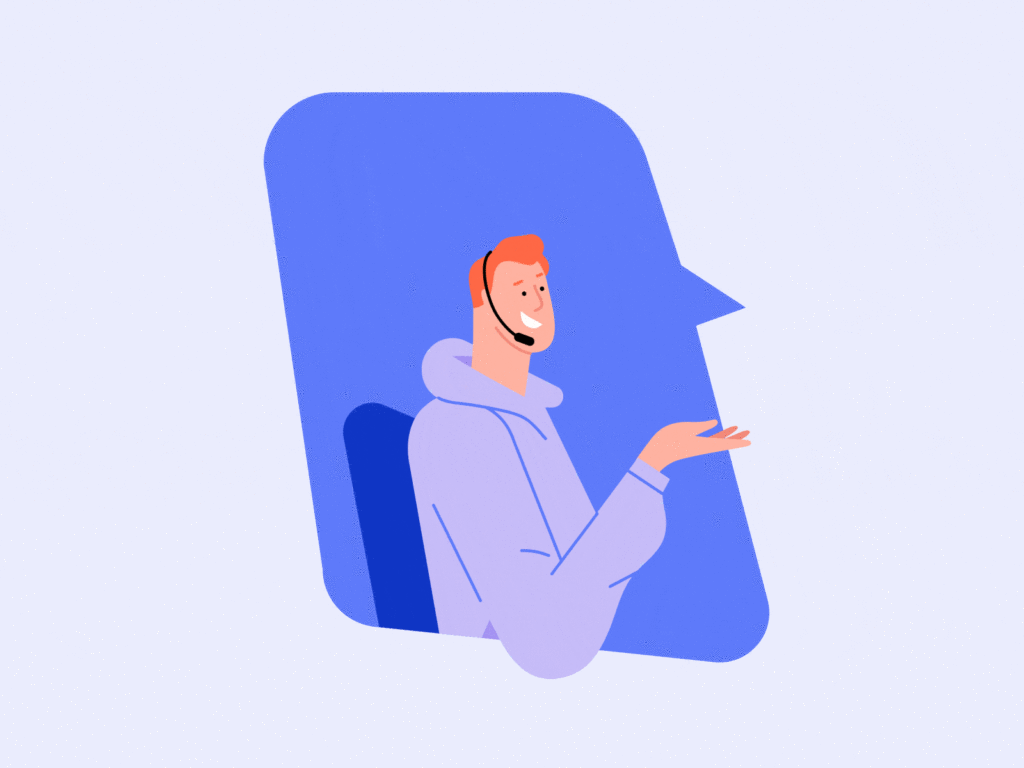
In a general sense, AI agents are software systems powered by artificial intelligence designed to handle tasks traditionally performed by humans. These agents operate independently or assist in multiple industries, enhancing productivity through machine learning. In customer service, AI chatbots and virtual assistants perform essential support tasks, answer FAQs, and offer instant responses on demand.
AI customer service agents analyze vast amounts of data to provide quick, tailored, and round-the-clock support, simulating human-like interactions. Key functionalities include:
- Automating Repetitive Tasks: AI agents handle routine customer service tasks like FAQs and order tracking, freeing human agents for complex queries.
- Personalized Responses: With CRM integration, AI agents tailor responses based on each customer's history and preferences.
- 24/7 Availability: AI-powered customer service chatbots provide around-the-clock support, enhancing customer satisfaction and minimizing the need for live agents.
With these features, AI customer service solutions significantly boost response times, efficiency, and customer satisfaction across support channels.
How Can AI Agents in Customer Service Help Businesses in 2025?
AI agents are transforming customer service by supporting businesses in various key areas, providing not just efficiency but also scalability and enhanced customer experience. Here’s a look at how AI customer service chatbots, software, voice assistants, and specialized roles are contributing to this shift.
Customer Service Chatbots
AI-powered customer service chatbots are central to modern support systems, automating responses to frequently asked questions, processing orders, and resolving common issues instantly. These AI chatbots engage with customers in real-time, 24/7, handling high volumes of inquiries with consistent accuracy. By providing quick, automated answers, these chatbots reduce wait times, enhance satisfaction, and allow human agents to focus on complex customer needs.
Customer Service Numbers
Integrating AI with traditional customer service numbers offers a streamlined, hybrid support system. Customers dialing in can interact with AI-driven voice assistants that route calls effectively, answer common questions, and perform initial troubleshooting before transferring calls to human agents when necessary. This blending of customer service numbers with AI reduces operational costs, improves first-call resolution rates, and offers a more responsive service experience.
Customer Service Software
Comprehensive AI customer service software solutions bring together machine learning, natural language processing (NLP), and data analytics to deliver personalized support. These platforms analyze customer history and preferences, providing tailored responses that enhance satisfaction. Businesses leverage AI-powered customer service software for real-time insights, sentiment analysis, and to predict customer needs, helping them resolve issues proactively.
Customer Service Voice Assistants
AI customer service voice technology enables businesses to deliver conversational, human-like support through voice-enabled devices. These AI voice assistants are capable of handling a wide range of tasks, from order status inquiries to guiding customers through technical troubleshooting. Voice-based AI is especially effective for hands-free, intuitive support, making it an ideal solution for busy customers who need quick answers on the go.
Customer Service Jobs and Specialist Roles
The rise of AI in customer service has also created new roles focused on AI management and implementation. AI customer service specialists play a crucial role in training AI systems, analyzing performance metrics, and fine-tuning chatbot and voice assistant interactions to better meet customer needs. These specialists bridge the gap between technology and human-centered support, ensuring that AI agents enhance the customer experience rather than replace personal interactions.
Core Features and Benefits of AI Customer Service Agents
- Predictive Analytics: AI agents analyze past interactions to predict customer needs, helping service teams resolve issues proactively.
- Customer Sentiment Analysis: AI tools can detect emotional tone, adjusting responses to maintain a positive experience. For example, detecting frustration allows an AI to reroute customers to a human agent, enhancing satisfaction.
- Real-Time, Cross-Channel Support: AI chatbots provide 24/7 support across various platforms like email, live chat, and social media, ensuring consistent service regardless of where the customer interacts.
- Self-Service Capabilities: AI enables customers to access FAQs and knowledge bases, empowering self-resolution and reducing demands on human agents.
- Scalability and Cost Efficiency: AI chatbots for customer service manage high inquiry volumes, supporting rapid growth and fluctuating demand while cutting costs by up to 30%.
Through these innovations, AI for customer service not only enhances satisfaction but also reduces operational costs significantly.
Top AI Agents for Customer Service in 2024
In 2024, several AI-powered agents are leading the way in customer service AI solutions, each offering unique features to transform support systems:
- CodeConductor: A Real-time solutions with predictive analytics for faster, more efficient customer service.
- Freshdesk: Automatically answers customer queries, enhancing team productivity.
- Zendesk: Provides self-service and guided support, enabling customers to find answers independently.
- Salesforce Einstein: AI-driven insights for personalized, high-impact support.
- ServiceNow: Anticipates and resolves customer issues proactively.
- IBM Watson Assistant: Personalized AI chatbot and virtual assistant experiences.
- Microsoft Power Virtual Agents: Chatbots that help customers quickly resolve issues.
These AI agents redefine customer service efficiency, each contributing unique capabilities like machine learning, predictive analytics, and natural language processing.
AI Agents and Omnichannel Customer Support
Today's customers expect consistent experiences, regardless of the platform. With omnichannel integration, AI customer service agents provide seamless support across live chat, email, and social media, keeping conversations contextually intact across touchpoints.
AI in customer service ensures:
- Cross-platform Messaging: AI-driven support across WhatsApp, Facebook Messenger, and more.
- Conversational AI: Tailored, interactive experiences that reflect each customer’s needs.
- Omnichannel Consistency: Real-time integration for cohesive customer support across all service channels.
Through these integrations, AI enhances support quality and responsiveness, significantly boosting customer satisfaction and brand loyalty.
Overcoming Customer Service Challenges with AI
AI agents effectively address several pressing challenges in customer service. For instance, they handle simple and complex queries alike, routing complex cases to human agents seamlessly. AI-based customer sentiment analysis also helps detect emotions, ensuring responses are appropriate and empathetic.
Moreover, AI customer service solutions are designed with data privacy in mind, employing encryption and compliance protocols to protect sensitive information.
Conclusion
AI for customer service is revolutionizing the industry, with tools that deliver real-time personalization, predictive insights, and cross-platform support. From predictive analytics to 24/7 omnichannel engagement, AI customer service agents are reshaping how businesses approach customer satisfaction.
If you're ready to implement AI in customer service, RedBlink Technologies specializes in tailoring cutting-edge AI solutions for your business. Contact us to discover how AI can transform your support strategy and drive customer satisfaction.
2025: The Year of AI Agents – How Autonomous Agents Are Revolutionizing Technology
When Marc Andreessen declared 2025 as "The Year of AI Agents" in his influential article "The Techno-Optimist Manifesto," few realized how prophetic his words would become. The GOAT project's breakthrough in early 2025 marked a watershed moment in AI development, demonstrating for the first time that autonomous agents could not only understand and execute complex tasks but also engage in sophisticated planning and decision-making.
Key Points of the Article:
- Marc Andreessen's Prediction: Marc Andreessen's declaration of 2025 as "The Year of AI Agents" has proven accurate, particularly with the breakthrough of the GOAT project, which demonstrated autonomous agents capable of executing complex tasks with strategic planning and decision-making.
- Architecture of Agency: Autonomous agents differ from traditional AI due to:
- Goal-oriented behavior
- Memory and learning capabilities
- Strategic planning
- Environmental awareness
- Social interaction
- Dynamic agent formation
- Autonomous value networks
- Scalable architecture
- Security-first design
- Human-agent symbiosis
- Real-World Applications: Agent networks developed by CodeConductor have shown remarkable results across various industries, including software development, content creation, and business operations.
The Dawn of a New Paradigm
The journey from ChatGPT to autonomous agents represents more than just technological progress – it signals a fundamental shift in how we think about artificial intelligence. While large language models gave us powerful tools for natural language processing and generation, they remained fundamentally reactive systems. The emergence of autonomous agents, as exemplified by projects like $GOAT, introduced something revolutionary: proactive AI systems capable of independent goal-setting and execution.
This transition mirrors the evolution of the internet itself. Just as Web1.0 gave us static information consumption, and Web2.0 enabled interactive social platforms, autonomous agents are ushering in a new era where AI systems can independently navigate, learn, and create value in the digital world.
Beyond Chat Interfaces: The AI Agent Revolution
What makes autonomous agents fundamentally different from their predecessors? The answer lies in their architecture of agency. Unlike traditional AI models that respond to prompts, autonomous agents possess:
- Goal-oriented behavior: The ability to understand and pursue objectives independently
- Memory and learning: Continuous adaptation based on experience
- Strategic planning: Breaking down complex tasks into manageable steps
- Environmental awareness: Understanding and responding to context
- Social capability: Interacting and collaborating with other agents
The $GOAT project demonstrated these capabilities in spectacular fashion, showing how agents could autonomously research, plan, and execute complex tasks while adapting to changing circumstances. This wasn't just an incremental improvement – it was a quantum leap in AI capability.
CodeConductor: Pioneering the Agent-First AI Approach
While GOAT demonstrated what was possible, CodeConductor is building the infrastructure to make agent-based systems practical and accessible. Our approach goes beyond single-agent architectures to create robust networks of collaborative agents that can tackle complex real-world challenges.
The key innovations that set CodeConductor apart include:
- Dynamic Agent Formation: Agents that can self-organize based on task requirements
- Autonomous Value Networks: Built-in mechanisms for value creation and distribution
- Scalable Architecture: Systems that can grow from simple tasks to complex operations
- Security-First Design: Robust protection mechanisms for agent interactions
- Human-Agent Symbiosis: Seamless integration between human and agent capabilities
Real-World Impact of AI Agents
Early applications of CodeConductor's agent networks are already showing remarkable results across various industries:
In software development, agent teams are autonomously handling code review, bug fixing, and documentation, reducing development cycles by up to 60%.
In content creation, networks of specialized agents collaborate to research, write, edit, and optimize content, producing high-quality materials at unprecedented speed.
In business operations, agent teams are streamlining workflows by autonomously managing schedules, coordinating meetings, and handling routine communications.
The Road Ahead
As Sam Altman noted, "The transition from models to agents will be as significant as the jump from pre-training to fine-tuning." We're witnessing the early stages of this transformation, and the implications are profound.
The agent revolution isn't just about automation – it's about augmentation. By creating systems of autonomous agents that can collaborate, learn, and adapt, we're building tools that will fundamentally enhance human capabilities rather than replace them.
The Challenge and Opportunity
However, this revolution also presents challenges. Questions about control, accountability, and the ethical implications of autonomous systems need careful consideration. CodeConductor is addressing these challenges head-on through:
- Transparent operation principles
- Clear governance frameworks
- Robust safety mechanisms
- Ethical guidelines for agent behavior
The Path Forward
As we stand at the beginning of the agent era, the potential is enormous. The success of projects like $GOAT has shown what's possible, but it's platforms like CodeConductor that will make these possibilities accessible and practical for everyday use.
We're not just building better AI tools – we're creating a new paradigm for human-machine collaboration. One where autonomous agents serve as capable partners in our daily work and creative endeavors.
The agent revolution is here, and its impact will be profound. As we continue to develop and refine these technologies, we're not just advancing AI – we're reimagining the very nature of work, creativity, and human potential.
Top 10 AI Agents for Content Creation in 2025: AI Tools & Trends
Ever find yourself asking, “How can I keep up with the endless demand for fresh, engaging content?”
Whether you're a business owner, a marketing pro, or a writer, keeping up with the rapid pace of content creation can feel overwhelming. The digital world is always hungry for more—more blog posts, more ads, more social media updates.
Yet, with so much content required, maintaining quality, relevance, and creativity can feel like a never-ending battle.
Now imagine if there was a way to delegate some of this work, freeing up your time while generating high-quality content. This is where AI content agents come into existence. These content agents backed by Artificial Intelligence are designed to help businesses, marketers, and entrepreneurs automate and optimize content creation.
Well, these AI agents have come a long way, not just in writing simple text but also in analyzing SEO trends, and tailoring writing assignments or tasks for different target audiences.
Did you know that the global AI text generator market size was estimated at USD 392.0 million in 2022 and is expected to grow at a compound annual growth rate (CAGR) of 17.3% from 2023 to 2030?
In this blog, we’ll explore the top AI content agents available today and explain how they work, what features to look for, and how they can transform your content strategy.
Whether you're looking to streamline your content workflow or just curious about how AI might fit into your marketing toolkit, this guide is for you.
So, without any further ado, let’s start!!!
What Are AI Agents for Content Creation?
Have you ever wondered what exactly AI agents are and how they fit into the content creation process?
Think of AI agents as virtual assistants powered by artificial intelligence, designed to handle content-related tasks. These agents use advanced algorithms like Natural Language Processing (NLP) and Machine Learning (ML) to generate text for various formats, such as blog posts, social media updates, marketing materials, and even entire reports.
Unlike traditional tools that require heavy human input, AI agents work autonomously by analyzing large datasets, understanding context, and crafting human-like content.
The real beauty of AI agents lies in their ability to adapt and improve over time. They learn from user feedback, engagement data, and past content to continuously optimize their output, ensuring that what they produce becomes more relevant and personalized.
But how are AI agents different from regular content tools?
The main difference is that AI agents go beyond simple automation—they actively learn and improve with every task.
For example, a marketing team can use an AI agent to create multiple email campaigns based on audience behavior data, and the agent will adjust and personalize future campaigns for better engagement.
Similarly, businesses can use AI agents to generate technical documentation or product descriptions without worrying about inconsistencies or time constraints.
Let’s think of AI content agents as intelligent assistants that handle repetitive tasks and enhance your content strategy. And with innovations like GPT-4, the quality of AI-generated content is now closer to human writing than ever before.
It’s like having a team of writers who work around the clock, ensuring you’re never behind on your content calendar.
With AI agents, you can:
- Automate high-volume content creation (blog posts, social media, etc)
- Personalize content to match specific audience segments
- Produce high-quality, data-driven content in a fraction of the time it would take a human.
Now that we know what AI agents are, let's look at how they meet the different content needs across various industries. Whether you're in marketing, media, or e-commerce, these agents are designed to handle a wide range of content needs. Let’s explore that in the next section.
AI Agents for Different Content Needs
From marketing products to generating articles for publication or creating business documents, AI agents can automate and enhance content creation across different platforms.
- Blogs and Long-Form Content:
AI agents are capable of generating well-researched, SEO-optimized blog posts in a fraction of the time it takes a human writer.
Whether you're running a personal blog or need content for corporate websites, AI can generate informative, relevant posts that cater to the target audience.
For instance, platforms like Jasper AI or Copy.ai can quickly produce drafts that require minimal editing, letting you scale content production without sacrificing quality.
- Social Media Posts:
Social media is an area where consistency is key, but creating engaging posts daily can become a time sink. AI tools like Lately.ai help analyze past engagement data to generate posts optimized for platforms like Twitter, Instagram, or LinkedIn. These tools ensure your social media content stays aligned with audience trends and engagement behavior, saving time and increasing productivity. - Video Content and Script Writing:
Video marketing has exploded, and AI agents are now used to generate video scripts, captions, and even video concepts. Tools like Lumen5 and Synthesia help marketers quickly turn text-based content into engaging videos or script outlines.
For businesses heavily invested in YouTube, social video content, or webinars, this can be a game changer.
- Marketing Products and Campaigns:
AI agents excel at creating SEO-optimized content for landing pages, product descriptions, and social media posts. Imagine you're launching a new product—your AI agent can instantly draft persuasive copy tailored for each segment of your audience, boosting conversions without you lifting a finger. - Publications and Media:
Journalists and digital publishers are often racing against the clock to produce timely, accurate stories. AI agents can take over the repetitive tasks, like summarizing lengthy articles or generating data-driven reports. Some publications already use AI to automate reports on financial earnings and sports recaps. This saves time and helps editors focus on more in-depth analysis and investigative reporting.
- Business and B2B Content:
AI agents can draft professional white papers, case studies, and client proposals, which are critical for business-to-business (B2B) communications.
For entrepreneurs, this means you no longer have to spend hours crafting intricate documents. AI-powered content creation tools can generate technically sound and well-structured documents, letting you engage clients with minimal effort.
Businesses that leverage AI for B2B content can focus more on growth strategies while maintaining the quality and professionalism of their communication materials.
- E-Commerce:
Last but not least, the e-commerce industry relies heavily on product descriptions, customer reviews, and category pages to drive conversions. AI content agents can generate hundreds of product descriptions that are SEO-friendly, consistent, and ready to publish, ensuring you maintain high-quality content across your entire catalog.
As we’ve seen, AI agents are incredibly versatile, meeting the unique content demands of industries ranging from marketing to video content creation. However, choosing the right AI agent requires a clear understanding of its key features and limitations.
In the next section, we’ll dive deeper into the core features you should look for when selecting an AI content agent and how these tools can help you optimize your content strategy.
Key Features of AI Content Agents
Choosing the right AI content agent for your needs can be challenging, especially when multiple options are available. To make an informed decision, it's important to understand the key features that set top-performing AI agents apart.
Key Features to Look for in AI Content Agents
- SEO Optimization
One of the standout features of any great AI content agent is its ability to optimize content for search engines. Look for tools that automatically integrate relevant keywords, craft SEO-friendly meta descriptions, and help structure your content with headings that boost ranking potential.
For example, CodeConductor.AI and Frase excel in generating content that is not only well-written but also tailored for SEO, ensuring your posts have the best chance of reaching a wider audience.
- Customization and Personalization
A powerful AI agent should allow you to customize the tone, style, and format of the content it generates. Whether you're writing a formal white paper or a casual blog post, the ability to tweak the content's voice to match your brand is crucial.
Some AI agents, like Copy.ai, offer customization options to create content that feels personalized and aligned with your brand’s messaging.
- Content Types and Flexibility
From long-form blog posts to social media snippets and video scripts, the more versatile an AI agent is, the better. AI tools like Lately.ai or CodeConductor.ai can generate multiple types of content, making it easier to maintain a consistent voice across all platforms.
For example, CodeConductor.ai excels in producing scalable, production-ready code that integrates with content workflows, perfect for businesses looking to automate content creation and backend development processes simultaneously.
- Natural Language Understanding (NLP)
AI agents rely heavily on Natural Language Processing (NLP) to ensure the generated content sounds human-like. NLP allows these tools understand context, tone, and even cultural nuances in the better way, resulting in content that doesn’t just feel like a machine wrote it.
For instance, CodeConductor.ai leverages advanced NLP to generate both written content and well-structured backend code, ensuring that the content resonates with its intended audience, and integrates seamlessly into technical systems. This blend of content creation and backend logic sets CodeConductor.ai apart by ensuring both sides of the content pipeline—communication and development—are equally optimized and cohesive.
- Scalability and Efficiency
One of the biggest advantages of AI content agents is their ability to produce large volumes of content quickly. Whether managing a blog with daily updates or running a multi-channel social media campaign, AI agents allow you to scale up your content creation efforts without compromising quality or deadlines.
Now that we've explored the AI agent's key features, let’s explore some of the best AI agents for content creation in 2025.
Top AI Agents for Content Creation in 2025
Long-Form Content (Blogs, Articles, Reports)
Short-Form Content (Social Media Posts, Ads, Product Descriptions)
SEO Optimization and Content Enhancement
E-Commerce and Product Descriptions
All-in-One Content Creation and Backend Automation
As we explore the list of the top AI content agents, it's clear that these tools can significantly enhance productivity and efficiency. However, with great power comes great responsibility.
While these agents can streamline content creation, it’s essential to consider the ethical implications of relying on AI for content.
From concerns about originality to potential biases, there are key ethical challenges that businesses must address as they adopt AI-driven content strategies.
Ethical Considerations in AI Content Creation
As AI becomes more integrated into content workflows, questions arise around originality, authenticity, and the potential for plagiarism.
1. Originality and Plagiarism
AI agents, particularly those that pull from vast datasets, run the risk of generating content that may closely resemble or even duplicate existing work.
Although most AI tools include plagiarism checker features to reduce this risk, it is still crucial for businesses to run plagiarism checks on AI-generated content before publishing.
Ensuring originality is not just about avoiding legal issues but also about maintaining the unique voice and message of your brand. While AI can expedite content creation, it is essential that human editors oversee the output to ensure it stands out and provides real value to the audience.
2. Content Authenticity
Content authenticity goes beyond plagiarism—it’s about creating trustworthy and credible material. AI agents, while capable of producing factually correct content, lack the human insight necessary for crafting authentic stories, making emotional connections, or offering in-depth analysis.
This raises concerns about whether AI-generated content may feel generic or devoid of real engagement.
Brands need to balance AI-driven efficiency with human oversight, ensuring that AI content aligns with their core values and resonates with their audience on a deeper level.
Transparency is key—if content is largely AI-generated, businesses may need to disclose this to their audience to maintain trust.
3. Bias in AI-Generated Content
Since AI tools are trained on existing datasets, there is a risk that they could perpetuate or even amplify biases present in those datasets. This can manifest in various ways, from subtle stereotyping to more overt biases that could harm a brand’s reputation.
Companies should be mindful of this and ensure that AI-generated content is reviewed for inclusivity, fairness, and accuracy before it’s published.
Did you know that USC researchers find bias in up to 38.6% of ‘facts’ used by AI?
Ensuring that the AI tools you use are constantly updated to mitigate bias and that content is reviewed by diverse teams can help prevent these ethical pitfalls.
As the use of AI in content creation expands, it’s crucial to address these ethical challenges.
But what does the future hold for AI agents in content creation? Let’s take a look at some of the most exciting upcoming trends and innovations.
The Future of AI Agents in Content Creation
The future of AI content creation is poised for remarkable advancements, with trends like hyper-personalization leading the way. AI agents will increasingly create tailored content for individual users based on real-time data and behavior.
As Natural Language Generation (NLG) evolves, AI will generate more nuanced, human-like content. Additionally, real-time content generation and AI-human collaboration will further streamline workflows, with AI enhancing, not replacing, human creativity. However, as AI becomes more advanced, ethical considerations such as transparency and bias mitigation will be essential for maintaining trust.
Conclusion: Unlocking the Potential of AI Agents for Content Creation
AI agents have transformed content creation, offering businesses the ability to produce high-quality, engaging material at scale. From automating repetitive tasks to creating personalized, SEO-optimized content, these tools provide unmatched efficiency and flexibility.
Ready to transform your content strategy? Book a free AI Consulting with our experts at Redblink.
Best AI Tools for B2B Marketing: A Comprehensive 2024 Guide
B2B AI Tools
Artificial Intelligence (AI) isn't just some futuristic concept anymore; it's a daily reality transforming B2B marketing in ways I never thought possible. As someone working in marketing, I know firsthand how challenging it can be to streamline operations, increase productivity, and run impactful campaigns. But here's the good news – several AI tools or platforms for B2B marketing are here to help us do all that and more!
With the right AI tools for B2B marketing in place, I've seen how it’s possible to elevate marketing strategies, allowing you to stand out in the competitive B2B market. Let me take you through some of the top Artificial Intelligence tools for B2B marketing out there right now, and how you can use them to give your marketing efforts a serious boost.
Why I Believe AI is Essential for B2B Marketing
AI has brought automation, efficiency, and some seriously advanced data analysis to the table. It’s now handling the mundane tasks that used to eat up my day, analyzing complex data patterns, and even helping to deliver personalized experiences to clients.
And let’s be real: in B2B marketing, where decisions are data-driven and buying cycles are way longer, having AI tools is necessary for nurturing leads and crafting high-impact strategies.
But which AI tools for Business-to-Business marketing should we invest our time (and budget) in? I’ve done some digging and testing, and here’s my rundown of the top AI tools that can truly make a difference in your B2B marketing success. Before diving into the tools, let’s take a moment to look at some key statistics from "The Big Book of Artificial Intelligence Statistics for B2B Practitioners." These drive home just how transformative AI is becoming for marketers like us.
Approximately 96% of marketers are either already using AI or planning to use it, focusing primarily on improving productivity (76%) and enhancing customer engagement (52%). I mean, that’s almost every marketer out there – including myself – recognizes AI as a game-changer for streamlining workflows and delivering more personalized customer experiences.
And here's the kicker: among organizations that have recently invested in an AI platform, a whopping 83% reported positive returns on investment. The main metric for measuring this ROI? Employee productivity is cited by 44% of those organizations. These stats paint a clear picture: AI isn't just a trend; it's a powerful tool that's delivering real results in B2B marketing.
It’s about making our processes more efficient, engaging customers in more meaningful ways, and ultimately, driving better business outcomes. This is exactly why I’m excited to dive into how these AI tools can work wonders for your marketing strategy. Now, let's explore some of the best AI tools available, starting with my personal favorite: CodeConductor.
1. CodeConductor: Build Customized Marketing AI Agents
https://codeconductor.ai/wp-content/uploads/2024/08/CC-LP-Banner-Video-1.mp4
When it comes to developing tailored marketing AI agents, CodeConductor is a platform I’ve found to be incredibly valuable. They offer powerful solutions to create custom AI agents designed to fit specific marketing needs – from chatbots to automated content generators. Unlike off-the-shelf tools, CodeConductor.ai provides the flexibility to build AI agents that align perfectly with your unique marketing strategy.
Here’s How It Helps Me:
- Custom AI Agent Development: With CodeConductor.ai, I can design AI agents that manage tasks like customer support, lead nurturing, and content personalization, allowing my marketing to operate around the clock.
- Enhanced Customer Engagement: The platform allows me to develop chatbots and conversational agents that interact with customers in a more human-like manner, collecting valuable insights and guiding prospects through the sales funnel seamlessly.
- Automation and Optimization: By creating AI agents specifically tailored to my business processes, I can automate repetitive marketing tasks, like email follow-ups and social media scheduling, while optimizing strategies based on real-time data analysis.
Why I Love It: CodeConductor.ai empowers me to go beyond basic AI capabilities and create marketing agents that truly fit my brand’s voice and objectives.
2. HubSpot’s Marketing Hub: AI-Powered Inbound Marketing
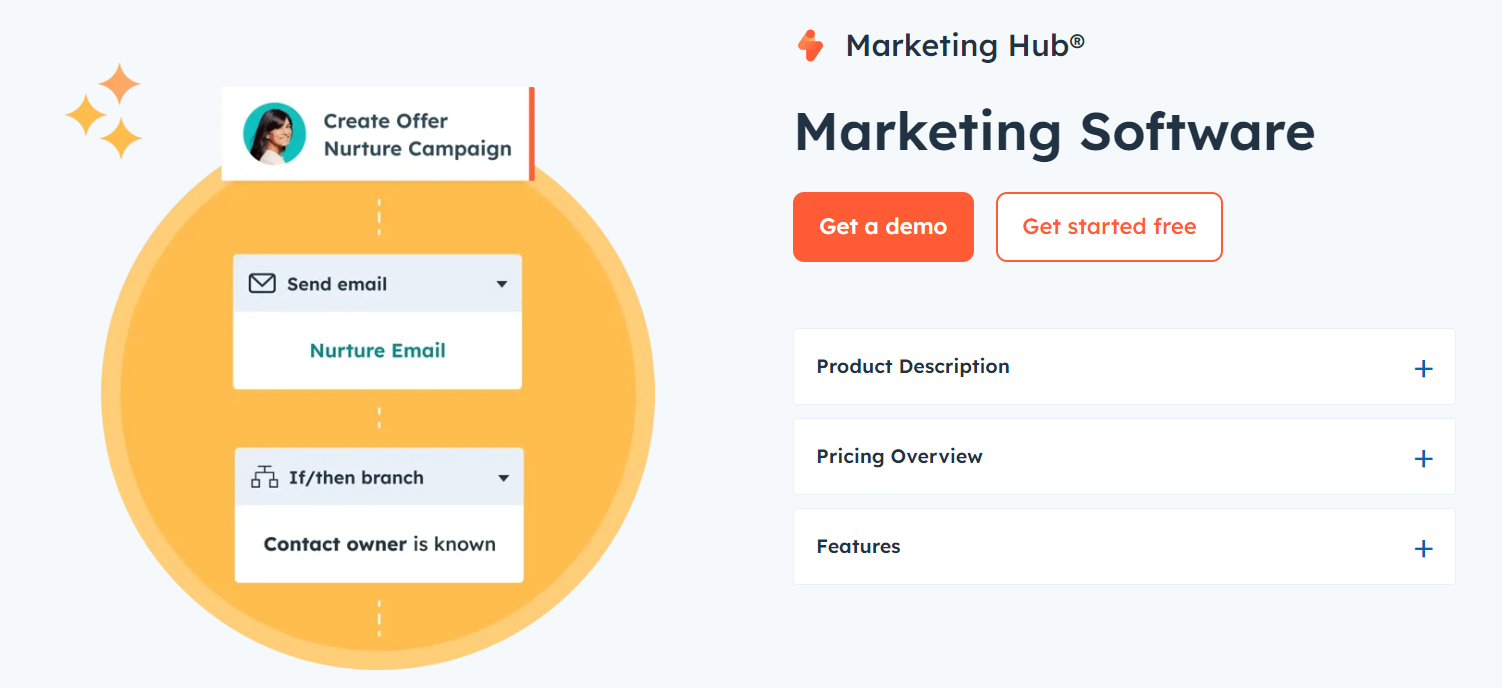
I've been using HubSpot’s Marketing Hub for a while now, and their AI integration is simply a game-changer. It provides insights for content creation, lead scoring, and customer segmentation in ways I couldn’t have imagined before.
With its AI-driven chatbots, predictive lead scoring, and personalized content recommendations, it’s become my all-in-one platform for streamlining marketing campaigns.
Here’s How It Helps Me:
- Content Optimization: The AI suggests topics, headlines, and even keywords that my target audience is likely to engage with. I no longer have to second-guess my content strategy.
- Enhanced Lead Scoring: Its predictive models pinpoint which leads are most valuable, so my sales team can focus their efforts on prospects who are most likely to convert.
- Chatbots: These chatbots interact with prospects around the clock, qualifying leads and answering common queries even when I'm off the clock.
Why I Love It: HubSpot’s AI makes it so much easier to understand the customer journey and craft marketing strategies that actually work.
3. Jasper AI: AI-Driven Copywriting for My Campaigns
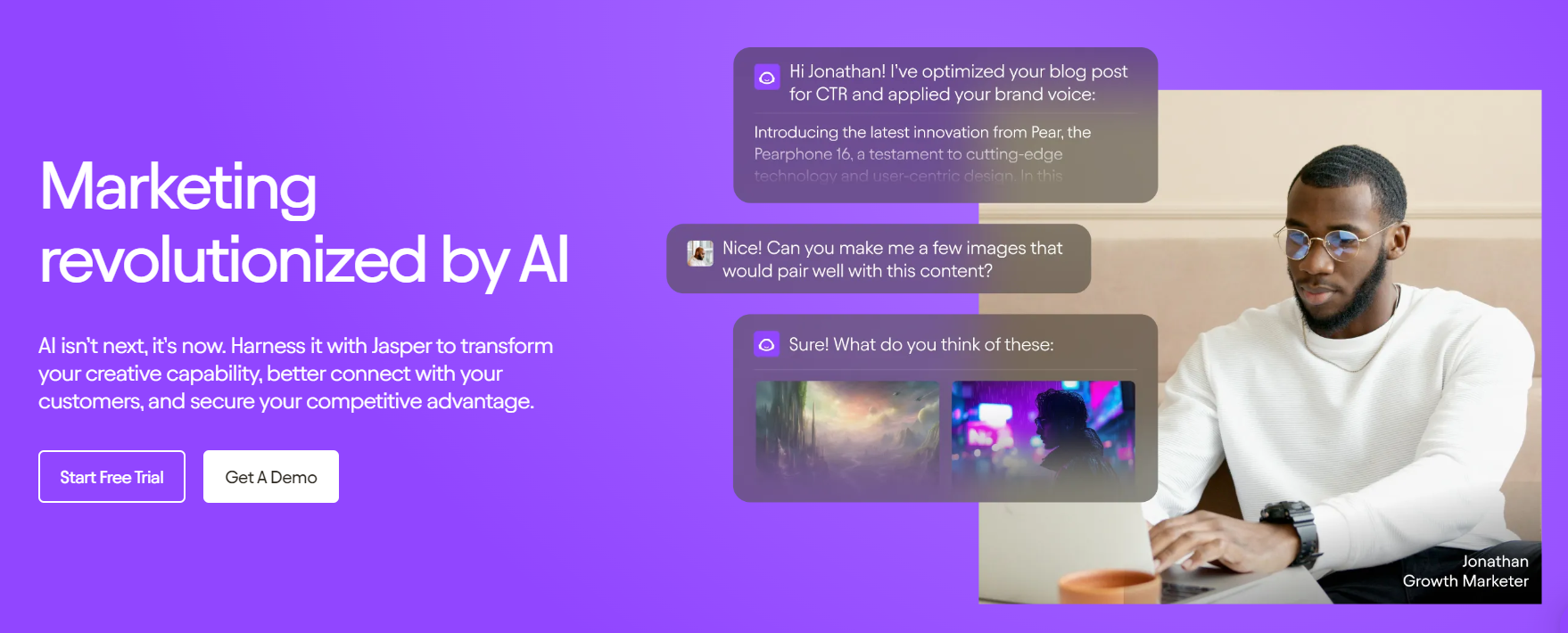
Content creation is a huge part of my job, and Jasper AI has become my go-to for generating engaging copy across multiple channels. Whether for blogs, emails, or social media, this AI tool nails it every time.
Here’s How It Helps Me:
- Content Personalization: I can tailor the copy to different customer personas, ensuring that my messaging is always on point.
- Speed and Efficiency: Creating content used to take ages, but now I can whip up high-quality pieces in no time.
- SEO Optimization: Jasper integrates with SEO tools, suggesting keywords and phrases to improve my content’s visibility.
Why I Love It: With Jasper, I created diverse, high-impact content across platforms while maintaining brand consistency, all in record time.
4. ChatGPT 4: The Versatile AI Conversationalist I Can’t Do Without

If there's one tool that's been a lifesaver for both internal and external communications, it's ChatGPT. I've used it for everything from automating customer support to brainstorming campaign ideas.
Here’s How It Helps Me:
- Lead Nurturing: I implemented ChatGPT-powered chatbots on our website to engage with visitors, answer questions, and even collect contact information.
- Customer Support: Automating responses to common queries has freed up my time for more complex interactions.
- Content Creation: When I’m stuck in a rut, I use ChatGPT to generate draft content for blogs, emails, and other marketing materials.
Why I Love It: Its conversational nature makes ChatGPT incredibly versatile for different marketing tasks, not to mention how much time it saves me.
In a survey conducted in the United States in March 2023, 55 percent of marketers said that they use ChatGPT for their marketing purposes. Another 42 percent of marketers used Copy.ai - a natural language processing software that produces product descriptions and social media content - for the same reasons.
5. Copy.ai: AI-Powered Copywriting for Effortless Content Creation
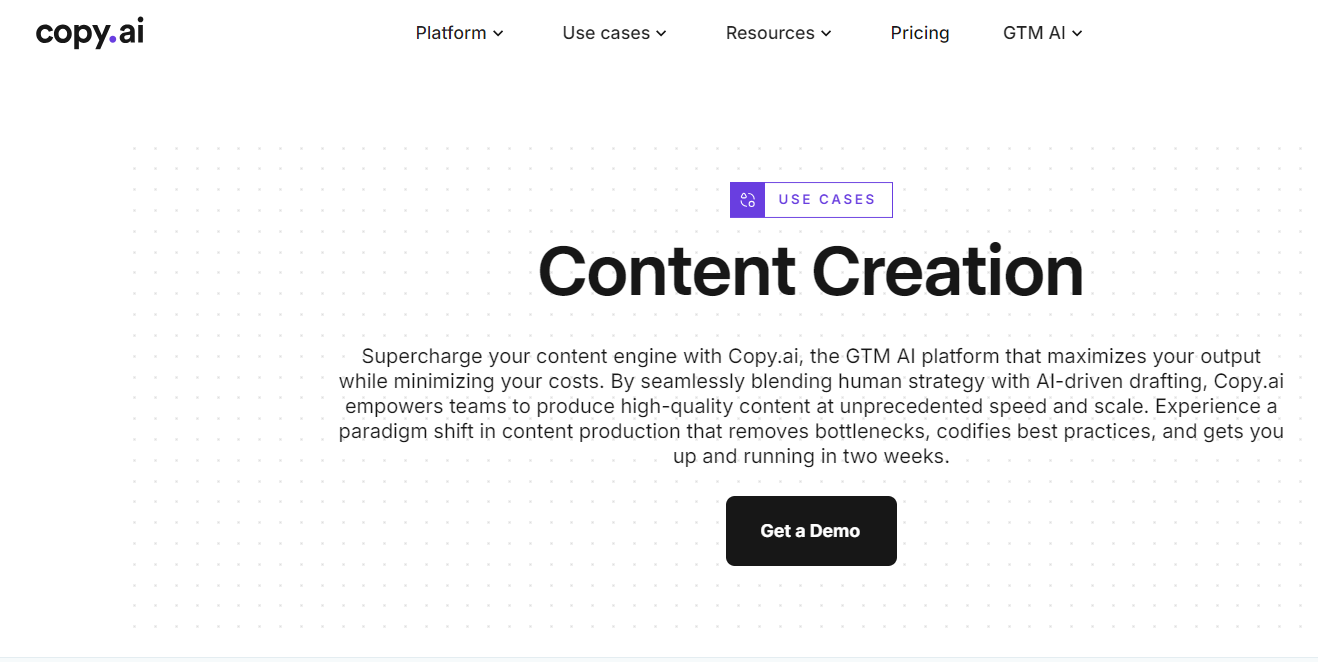
If creating compelling content is a big part of your marketing strategy, Copy.ai is another tool you’ll want to have in your arsenal. It uses advanced natural language processing (NLP) to generate high-quality copy for emails, blog posts, ads, social media, and more, saving you time while keeping your content engaging and tailored to your audience.
Here’s How It Helps Me:
- Diverse Content Generation: Copy.ai is incredibly versatile, helping me quickly generate various types of content – from catchy headlines to long-form blog posts – without getting bogged down in the writing process.
- Personalized Copy: The AI can adapt the tone, style, and structure of the copy based on the target audience, ensuring that my messaging aligns with different customer segments.
- SEO Integration: With Copy.ai, I can generate SEO-friendly content, including keyword suggestions and optimized phrases, helping improve my organic search visibility.
Why I Love It: Copy.ai significantly cuts down the time spent on content creation while ensuring the copy is tailored and optimized for my marketing campaigns.
6. MarketMuse: AI for Content Strategy and SEO

MarketMuse is my secret weapon for content planning and SEO. It uses AI to analyze competitors, identify gaps, and provide SEO-driven recommendations, taking my content strategy to a whole new level.
Here’s How It Helps Me:
- Content Planning: I use its AI to analyze my website and competitors to uncover content gaps and suggest new topics.
- SEO Optimization: MarketMuse generates outlines and keyword suggestions that help my content rank higher.
- Performance Tracking: I can monitor content performance and get recommendations for updates, keeping my content relevant.
Why I Love It: MarketMuse makes it so much easier to boost organic search visibility and engagement through its AI-driven content strategies.
7. Clearbit: AI-Powered B2B Data Enrichment
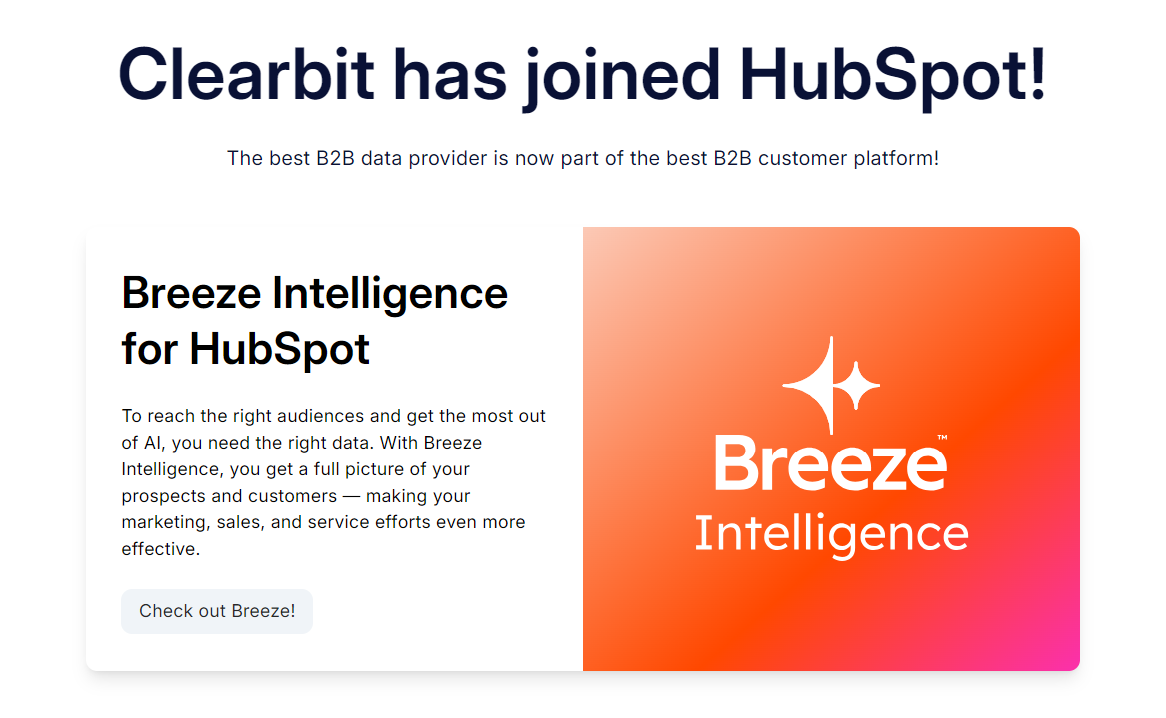
Clearbit has become my go-to for data enrichment. It uses AI to provide insights into customer demographics, firmographics, and online behavior, empowering me to personalize campaigns and refine my targeting.
Here’s How It Helps Me:
- Lead Enrichment: I no longer have to worry about missing information in my lead database; Clearbit automatically fills in details like company size, industry, and revenue.
- Personalized Outreach: With enriched data, I can craft marketing messages that are highly relevant to each prospect.
- Account-Based Marketing (ABM): Clearbit’s insights help me identify high-value accounts and tailor marketing strategies specifically for them.
Why I Love It: By automating data collection and analysis, Clearbit enables me to create campaigns that truly resonate with my target audience.
8. Drift: Conversational Marketing and AI Chatbots I Rely On
Drift specializes in conversational marketing, and I can’t tell you how much its AI-driven chatbots have changed the way I capture and convert leads.
Here’s How It Helps Me:
- Lead Qualification: Drift’s AI-powered chatbots engage website visitors and qualify leads before I even get involved. Plus, they can schedule meetings right on the spot!
- Personalized Customer Journeys: The AI tailors interactions based on the visitor’s profile, providing a much more personalized experience.
- Data-Driven Insights: By analyzing chatbot interactions, I get valuable insights into customer preferences and pain points.
Why I Love It: Drift’s conversational approach makes customer engagement feel natural while speeding up the sales process.
Did you know that Over 30 percent of business-to-business (B2B) marketers surveyed in the United States were using artificial intelligence (AI) for coding, chatbots, and design? Another 30 percent of the same professionals deployed AI software for presentations and content.
9. Crimson Hexagon (Brandwatch): AI for Social Listening and Analytics

Keeping up with market sentiment and customer behavior on social media used to be a headache. Now, with Crimson Hexagon, I get deep insights into market trends, competitor activities, and customer sentiment with just a few clicks.
Here’s How It Helps Me:
- Social Listening: I track brand mentions, competitor discussions, and industry trends to stay informed and ahead of the curve.
- Customer Sentiment Analysis: The AI categorizes social media conversations based on emotions, giving me a clear picture of how customers perceive my brand.
- Market Research: I identify trending topics and customer pain points, which help inform my content strategy and product development.
Why I Love It: Its AI-driven analytics have made market research and customer sentiment analysis a breeze, giving me the insights I need to make informed decisions.
10. PathFactory: AI-Driven Content Engagement
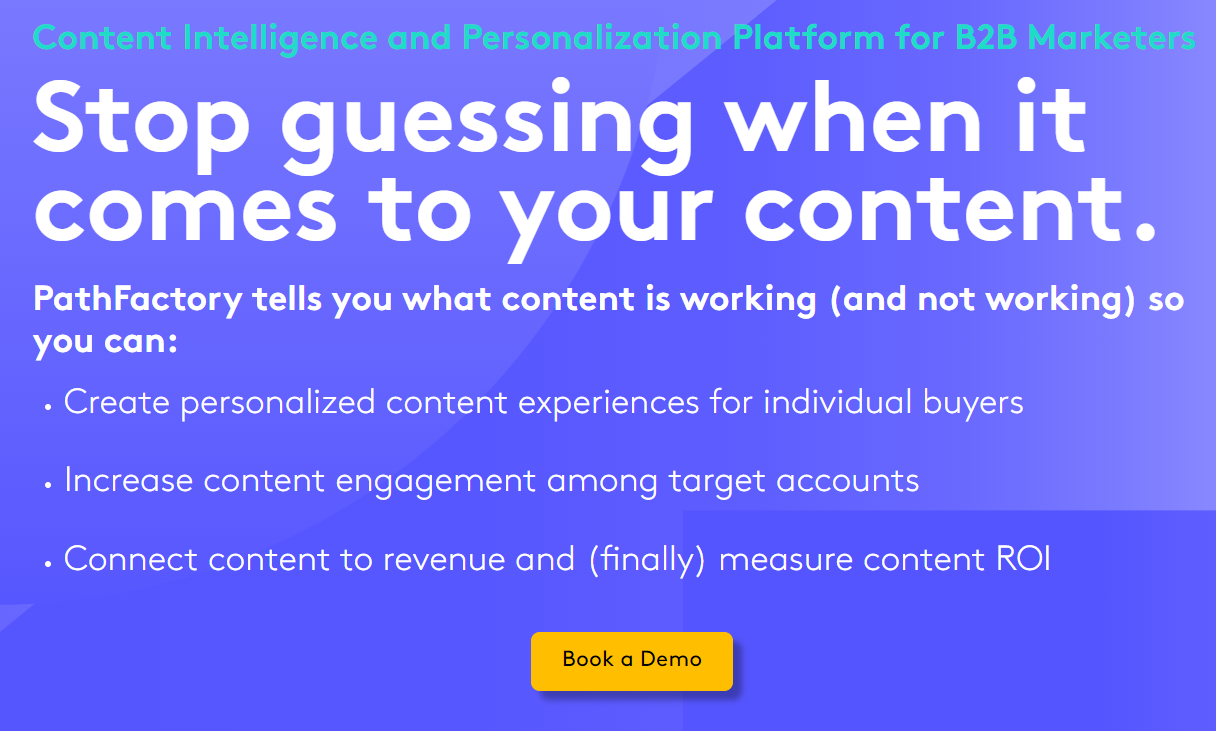
PathFactory has changed the way I guide prospects through the content journey. Its AI recommends relevant content based on user interactions, creating a curated experience that aligns perfectly with their interests.
Here’s How It Helps Me:
- Content Personalization: It recommends content tailored to the lead’s stage in the buying journey, making each interaction more relevant.
- Behavioral Insights: I can track how leads interact with the content, using this data to refine my strategies.
- Accelerate Sales Cycles: By delivering the right content at the right time, PathFactory helps shorten the buying cycle.
Why I Love It: Its AI-driven approach ensures that prospects receive the most relevant content, boosting engagement and speeding up conversions.
11. Loom: AI-Powered Video Communication
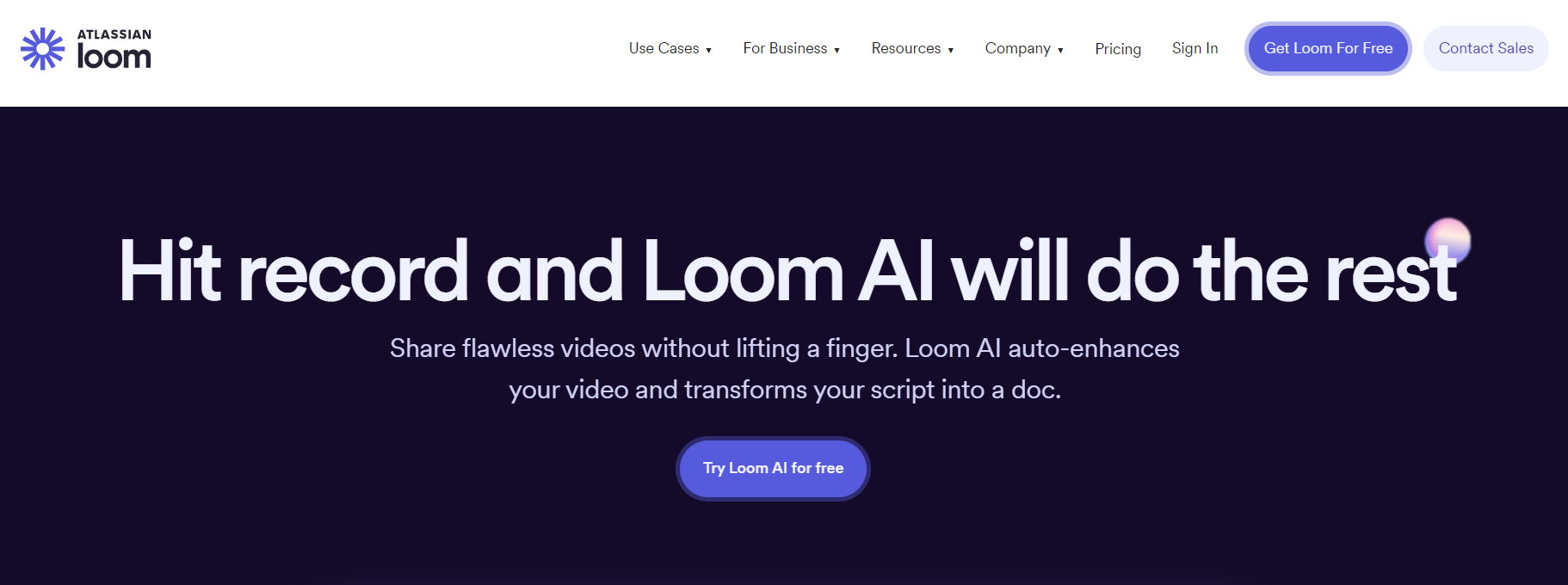
Loom has become an invaluable tool for my marketing communications, especially when I need to explain complex concepts quickly. It simplifies video content creation and sharing with it’s AI-powered video editing and transcription features.
Here’s How It Helps Me:
- Quick Video Creation: Whether it’s a product demo, tutorial, or a personalized sales message, Loom lets me record videos effortlessly, cutting down the need for lengthy meetings.
- AI-Driven Editing: I love that Loom uses AI to automatically generate transcriptions and even provide suggested edits, making my video content more accessible.
- Improved Customer Engagement: Personalized video messages can be a game-changer for customer interactions, helping me stand out in my communication.
Why I Love It: Loom’s AI capabilities make video creation a breeze and allow for more personal, impactful communication with clients and prospects.
12. Fireflies AI: AI-Powered Meeting Assistant
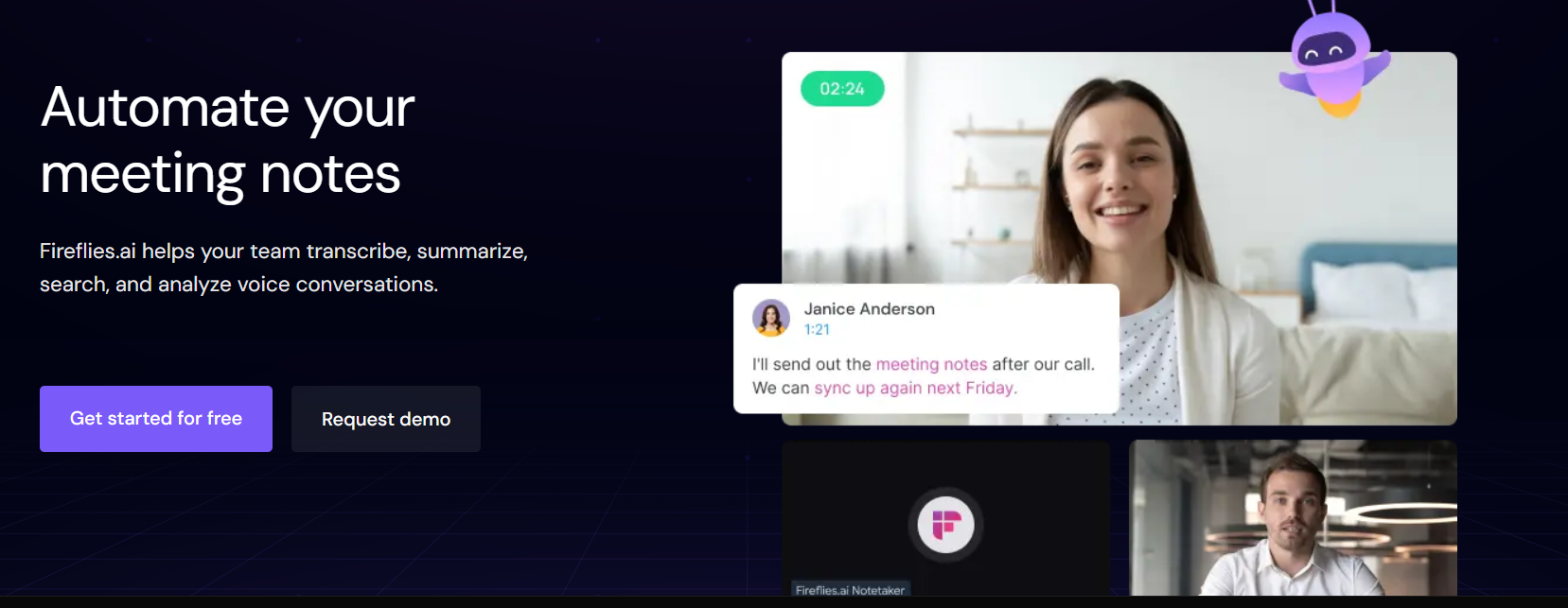
Fireflies AI has become my go-to for handling meeting notes and follow-ups. It’s an AI assistant that automatically transcribes, records, and analyzes conversations during virtual meetings, helping me focus on what’s important – building relationships and discussing strategies.
Here’s How It Helps Me:
- Accurate Transcriptions: Fireflies records and transcribes meetings accurately, so I never have to worry about missing key details.
- Actionable Insights: Its AI analyzes conversations to identify action items, making it easier to keep track of the next steps and follow-ups.
- Collaboration: I can share transcripts and insights with my team, enhancing collaboration and ensuring everyone is on the same page.
Why I Love It: Fireflies AI takes the stress out of note-taking during meetings, freeing me to fully engage with clients and colleagues.
13. Microsoft Clarity: AI-Powered User Behavior Analytics
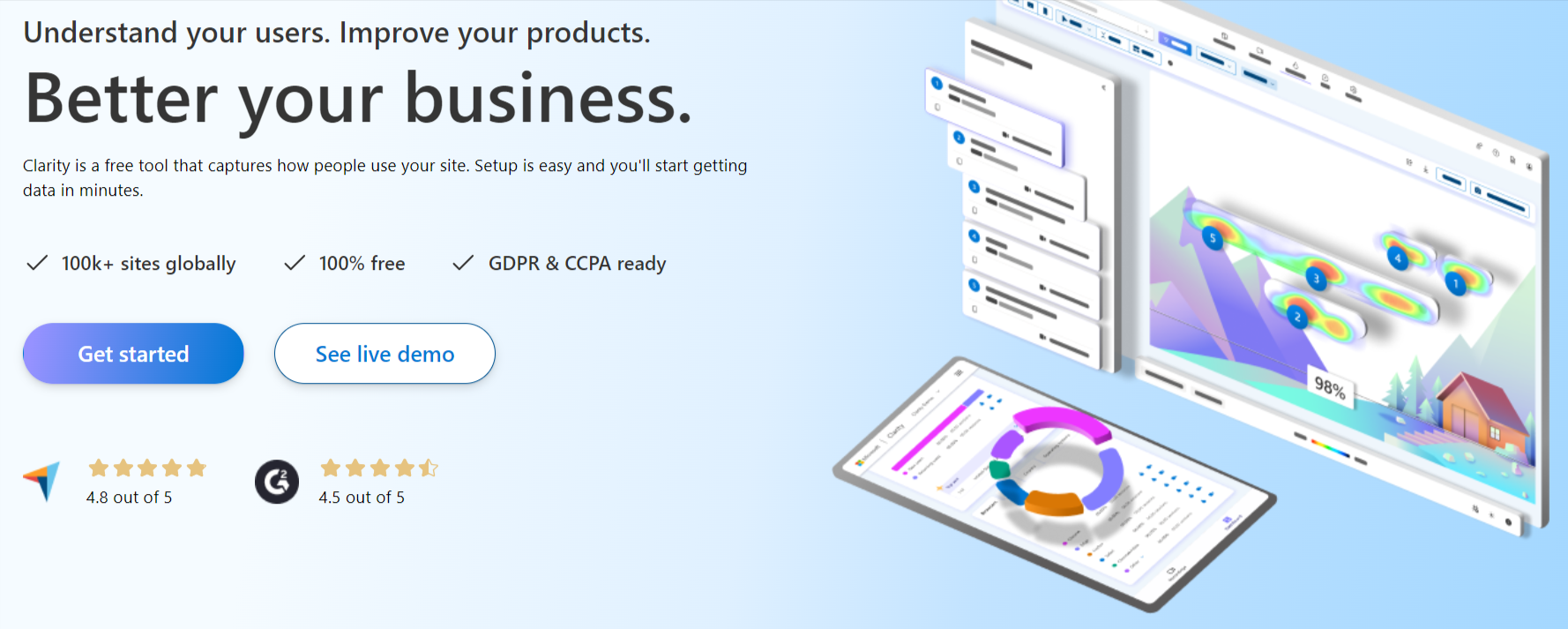
Understanding how users interact with my website is crucial, and Microsoft Clarity provides detailed insights into user behavior. Its AI-driven heatmaps, session recordings, and analytics give me a clear picture of how visitors engage with my content.
Here’s How It Helps Me:
- Behavior Analysis: Clarity’s AI tools reveal user behavior patterns, showing where visitors click, scroll, or get stuck.
- Session Recordings: Watching real-time session recordings helps me understand user journeys and identify areas of my website that need improvement.
- Heatmaps: Clarity’s heatmaps highlight the most engaging sections of my pages, so I can optimize content placement and design.
Why I Love It: The AI-driven insights help me fine-tune my website for a better user experience, ultimately increasing engagement and conversions.
14. ClickUp: AI-Powered Productivity for Marketing Teams

ClickUp is my go-to project management tool, and its AI-powered features help keep my marketing projects organized and on track. From campaign planning to content creation, ClickUp’s all-in-one platform supports everything I need to stay productive.
Here’s How It Helps Me:
- Automated Workflows: ClickUp’s AI can automate repetitive tasks, such as setting up reminders or assigning tasks based on project progress.
- Content Planning: I use it to plan content calendars, track campaign progress, and collaborate with my team, all within a single platform.
- Reporting: Its AI-generated reports give me insights into team productivity and project timelines, helping me optimize our marketing processes.
Why I Love It: ClickUp’s ability to centralize tasks and automate workflows keeps my team on the same page and ensures projects move forward seamlessly.
15. LinkedIn: AI for B2B Networking and Marketing
LinkedIn is a powerhouse for B2B marketing, and its AI-powered features help me find prospects, build relationships, and share content that resonates with my audience. From personalized connection suggestions to content performance analytics, LinkedIn’s AI capabilities are a game-changer.
Here’s How It Helps Me:
- Lead Generation: LinkedIn’s AI suggests potential connections and companies based on my profile and interests, streamlining my networking efforts.
- Content Optimization: The platform analyzes my posts' performance, providing insights on what resonates with my audience and when to post for maximum engagement.
- LinkedIn Sales Navigator: This tool uses AI to suggest leads that fit my target profile, making it easier to find, and engage with decision-makers.
Why I Love It: LinkedIn’s AI features allow me to network more effectively, engage with high-value leads, and tailor my content to meet my audience’s needs.
16. Slack: AI-Powered Team Communication and Collaboration
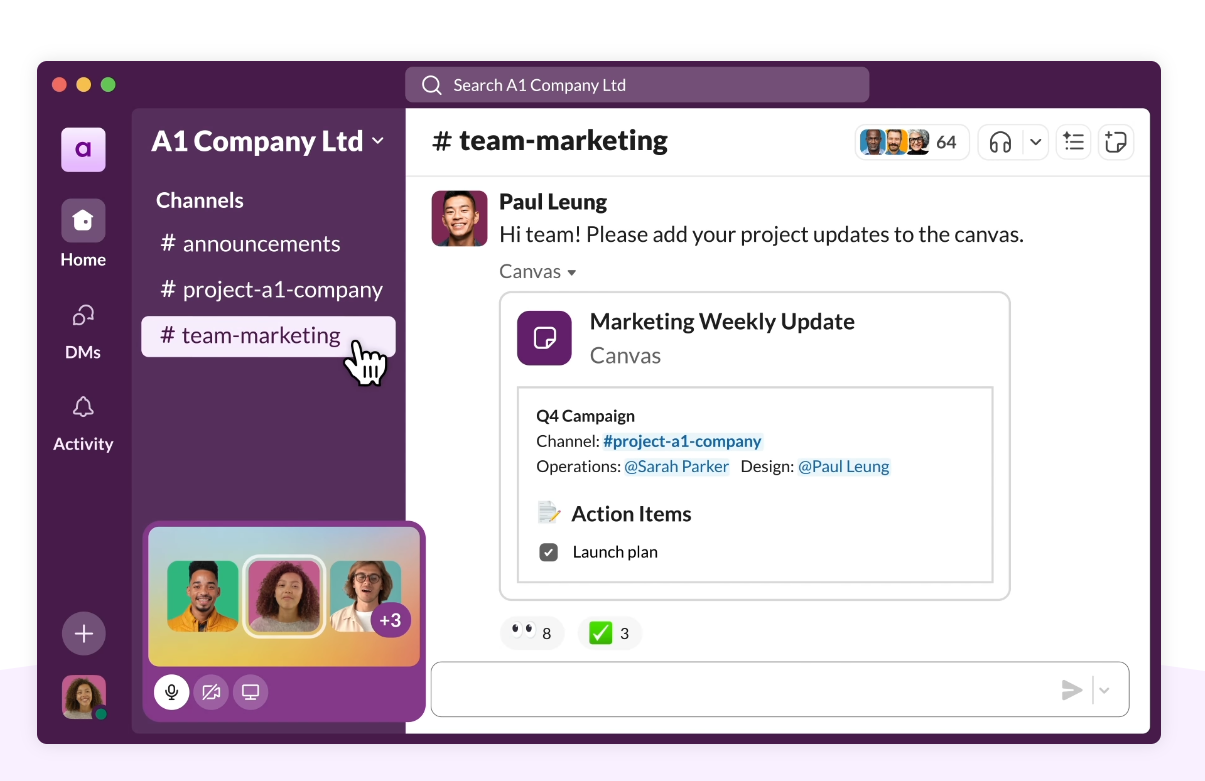
Slack isn’t just a messaging app; its AI-powered features help me streamline communication and collaboration within my marketing team. From automating repetitive tasks to integrating with other AI tools, Slack keeps our workflow smooth and efficient.
Here’s How It Helps Me:
- Automated Notifications: Slack’s AI-powered bots notify me about important updates, deadlines, and project statuses, so I never miss a beat.
- Integrations: I’ve integrated Slack with other AI tools, such as Fireflies for meeting transcripts and ClickUp for project updates, centralizing our workflow in one place.
- Enhanced Collaboration: With channels and AI-powered search capabilities, my team can easily find the information and collaborate on projects more effectively.
Why I Love It: Slack’s AI-driven features save me time, improve team collaboration, and ensure that all communication is organized and accessible.
17. Motion: AI for Scheduling and Task Management

Motion uses AI to manage my calendar, helping me prioritize tasks and schedule meetings efficiently. It’s like having a personal assistant that automatically adjusts my calendar based on task importance, deadlines, and meeting availability.
Here’s How It Helps Me:
- Automated Scheduling: Motion’s AI schedules my meetings based on availability, reducing the back-and-forth of manual scheduling.
- Task Prioritization: It uses AI to prioritize my to-do list, ensuring I focus on high-impact tasks and stay on track with deadlines.
- Adaptable Calendar: The tool automatically reschedules tasks if something unexpected comes up, keeping my workflow flexible and organized.
Why I Love It: Motion’s AI-driven scheduling and task management features help me make the most of my time, stay focused on high-priority tasks, and minimize disruptions.
My Final Thoughts on Using AI in B2B Marketing
AI tools have been a game-changer for me in creating personalized, data-driven campaigns that drive results. By leveraging these top AI tools, I’ve been able to streamline processes, enhance customer engagement, and make smarter decisions based on real data.
Key Takeaways:
- Integrate AI for data enrichment, content creation, and lead scoring to optimize marketing strategies.
- Use conversational AI tools to automate interactions and efficiently nurture leads.
- Employ AI-driven analytics to understand market sentiment, customer behavior, and content performance.
AI isn't just another tool in the toolbox; it's a strategic partner that empowers us as marketers to be more efficient and customer-focused.
If you haven’t started using AI yet, what are you waiting for???
Trust me, the sooner you embrace AI in your marketing efforts, the sooner you’ll start seeing its transformative benefits and Redblink Technologies is your ideal partner to make it happen. Let's work together to turn AI into your strategic advantage!
Other Resources
- Top 13 Free AI Tools / Apps for Students
- Top 10 Generative AI Tools for Marketing
- Top 30 AI Tools & Applications for Lead Generation


